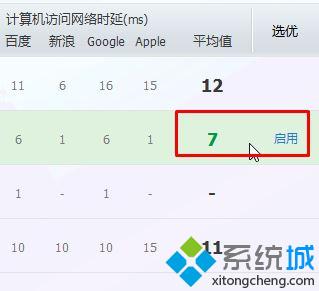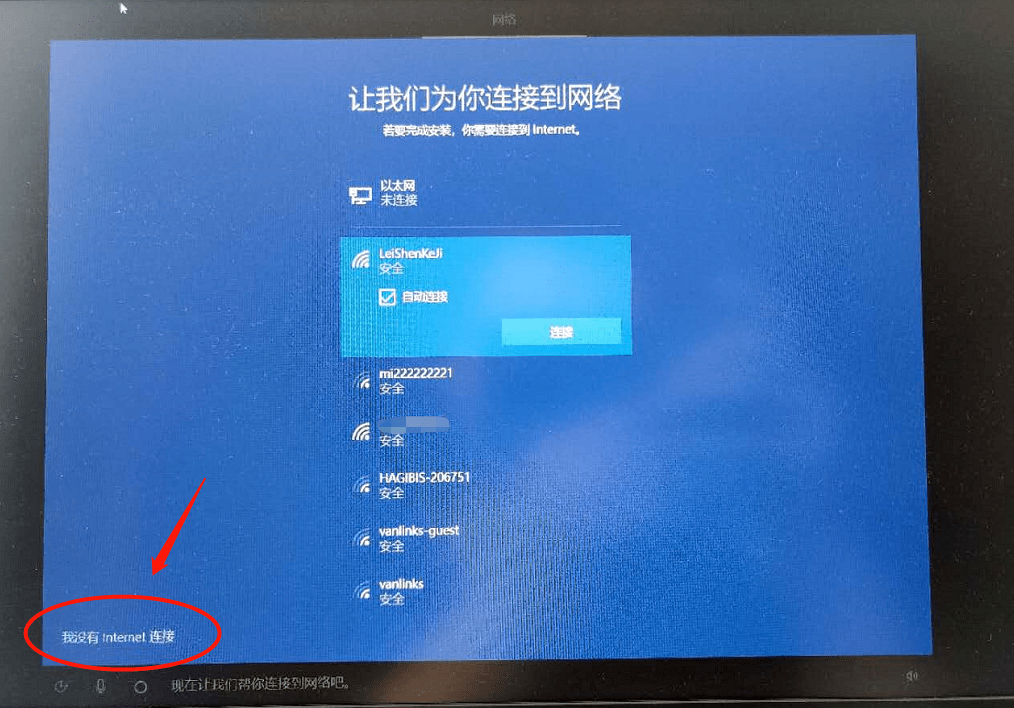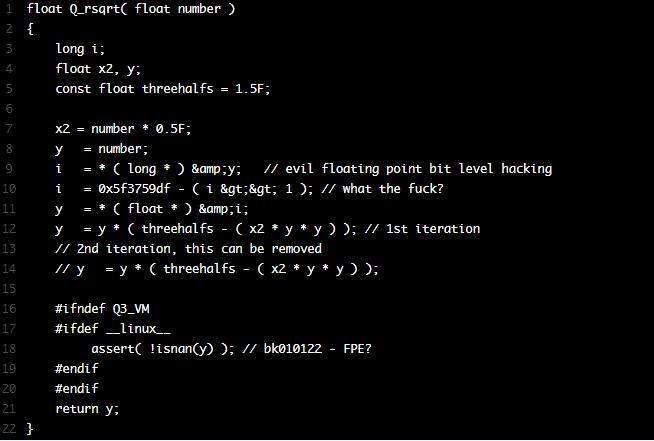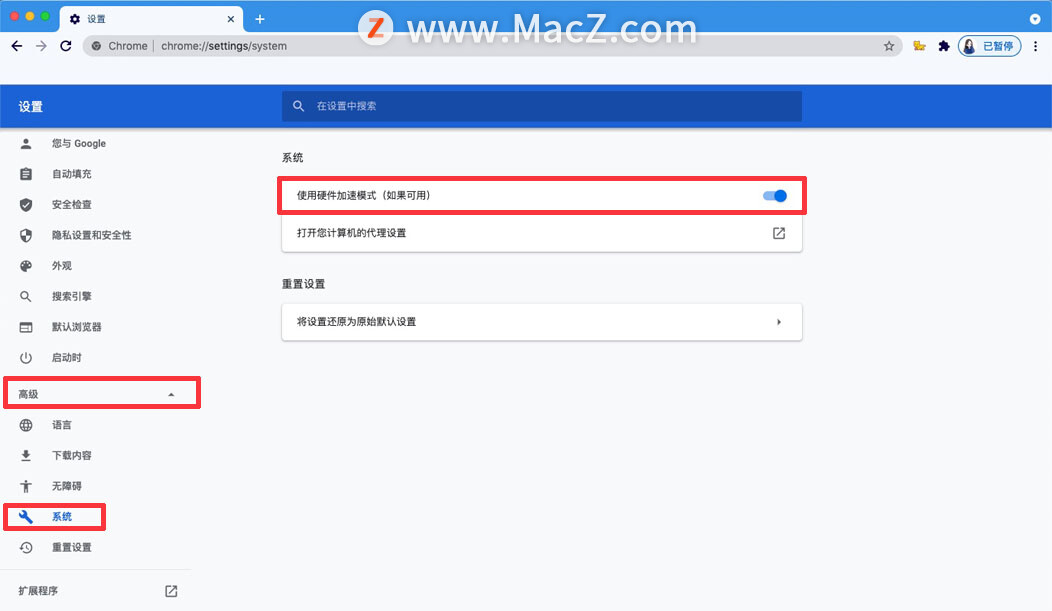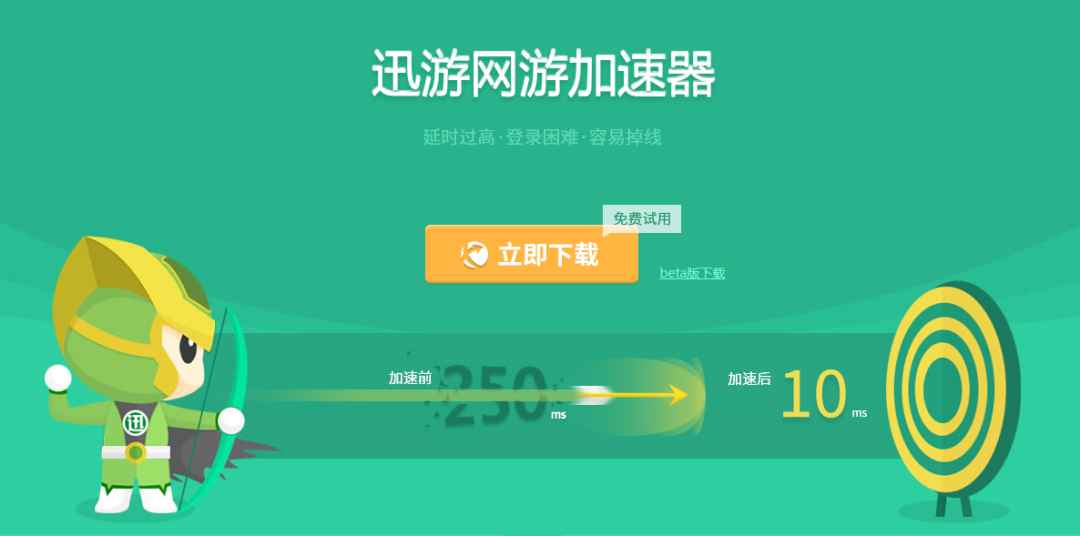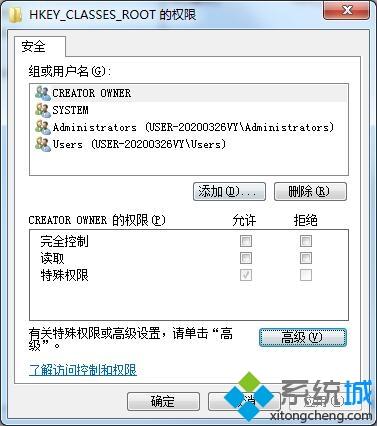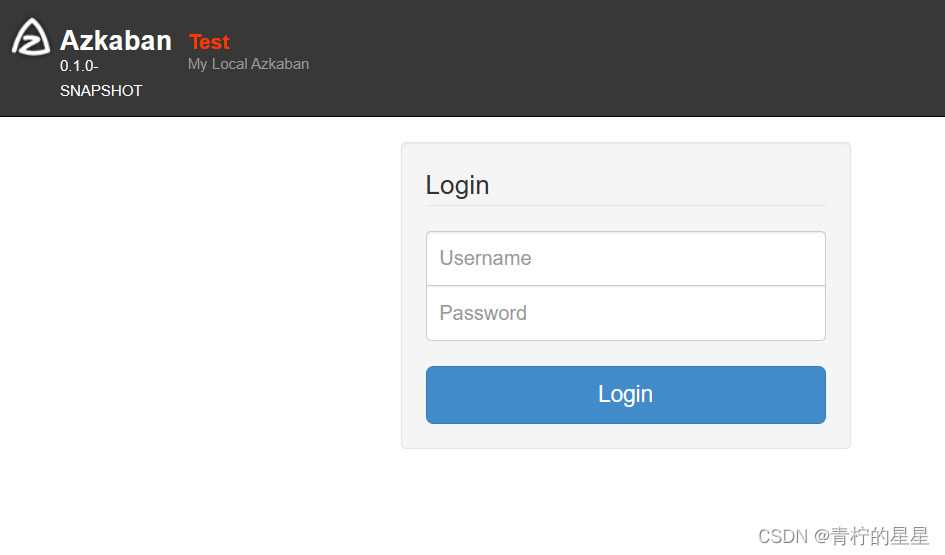学习要求
- 熟悉Spring基础
- 熟悉Maven使用
环境要求
- Java8及以上
- Maven 3.3及以上:https://docs.spring.io/spring-boot/docs/current/reference/html/getting-started.html#getting-started-system-requirements
学习资料
-
文档地址: https://www.yuque.com/atguigu/springboot
-
- 文档不支持旧版本IE、Edge浏览器,请使用chrome或者firefox
-
视频地址: http://www.gulixueyuan.com/ https://www.bilibili.com/video/BV19K4y1L7MT?p=1
-
源码地址:https://gitee.com/leifengyang/springboot2
1、入门
1、入门
雷神的笔记
https://www.yuque.com/atguigu/springboot/lcfeme
1.maven配置
<mirrors><mirror><id>nexus-aliyun</id><mirrorOf>central</mirrorOf><name>Nexus aliyun</name><url>http://maven.aliyun.com/nexus/content/groups/public</url></mirror></mirrors><profiles><profile><id>jdk-1.8</id><activation><activeByDefault>true</activeByDefault><jdk>1.8</jdk></activation><properties><maven.compiler.source>1.8</maven.compiler.source><maven.compiler.target>1.8</maven.compiler.target><maven.compiler.compilerVersion>1.8</maven.compiler.compilerVersion></properties></profile></profiles>
2.helloword
3.创建maven工程
4.创建主程序
5.编写业务
6.测试
7.简化配置
8.简化部署
打包成jav包
maven操作,clear、packedgs,打包的项目在target目录下。
在服务器上运行,java -jar name.jar
2、了解自动配置的原理
1、springboot特点
1.1、依赖管理
父项目做依赖管理
无需关注版本号,自动版本仲裁
可以修改默认版本号
就近优先原则,子项目如果没有配置,使用父项目的配置
1、见到很多 spring-boot-starter-* : *就某种场景
2、只要引入starter,这个场景的所有常规需要的依赖我们都自动引入
3、SpringBoot所有支持的场景
https://docs.spring.io/spring-boot/docs/current/reference/html/using-spring-boot.html#using-boot-starter
4、见到的 *-spring-boot-starter: 第三方为我们提供的简化开发的场景启动器。
5、所有场景启动器最底层的依赖
<dependency><groupId>org.springframework.boot</groupId><artifactId>spring-boot-starter</artifactId><version>2.3.4.RELEASE</version><scope>compile</scope>
</dependency>
自动配置的核心配置
1.2、自动配置
- 自动配好tomcat
- 引入tomcat
- 配置tomcat
<dependency><groupId>org.springframework.boot</groupId><artifactId>spring-boot-starter-tomcat</artifactId><version>2.3.4.RELEASE</version><scope>compile</scope></dependency>
-
自动配好SpringMVC
-
- 引入SpringMVC全套组件
- 自动配好SpringMVC常用组件(功能)
-
自动配好Web常见功能,如:字符编码问题
-
- SpringBoot帮我们配置好了所有web开发的常见场景
-
默认的包结构
-
- 主程序所在包及其下面的所有子包里面的组件都会被默认扫描进来
- 无需以前的包扫描配置
- 想要改变扫描路径,@SpringBootApplication(scanBasePackages=“com.atguigu”)
-
-
- 或者@ComponentScan 指定扫描路径
-
-
各种配置拥有默认值
-
- 默认配置最终都是映射到某个类上,如:MultipartProperties
- 配置文件的值最终会绑定每个类上,这个类会在容器中创建对象
-
按需加载所有自动配置项
-
- 非常多的starter
- 引入了哪些场景这个场景的自动配置才会开启
- SpringBoot所有的自动配置功能都在 spring-boot-autoconfigure 包里面
3、两大特性IOC(控制反转)和Aop(面向切面编程)
2、容器功能
@SpringBootApplication
//想要改变扫描路径,默认扫描规则。@SpringBootApplication(scanBasePackages=**"com.atguigu"**)
@ComponentScan
//主配置类
@SpringBootApplication等同于@SpringBootConfiguration
@EnableAutoConfiguration
@ComponentScan ("com.zsw")指定扫描路径
2.容器功能
2.1、组件添加
bean的作用相当于实例化一个对象,实例的对象之间有所依赖。
1、Configuration
2、@Bean、@Component、@Controller、@Service、@Repository
3、@ComponentScan、@Import
就相当于给容器中导入配置。
* 4、@Import({User.class, DBHelper.class})
//给容器中自动创建出这两个类型的组件、默认组件的名字就是全类名@Import({User.class, DBHelper.class})
@Configuration(proxyBeanMethods = false) //告诉SpringBoot这是一个配置类 == 配置文件
public class MyConfig {
}
4、@Conditional
条件装配:满足Conditional指定的条件,则进行组件注入。
[外链图片转存失败,源站可能有防盗链机制,建议将图片保存下来直接上传(img-j4Hpj59T-1650439603416)(C:\Users\ZSW\AppData\Roaming\Typora\typora-user-images\image-20220326213747043.png)]
2.2、原生配置文件引入
1、@ImportResource
======================beans.xml=========================
<?xml version="1.0" encoding="UTF-8"?>
<beans xmlns="http://www.springframework.org/schema/beans"xmlns:xsi="http://www.w3.org/2001/XMLSchema-instance"xmlns:context="http://www.springframework.org/schema/context"xsi:schemaLocation="http://www.springframework.org/schema/beans http://www.springframework.org/schema/beans/spring-beans.xsd http://www.springframework.org/schema/context https://www.springframework.org/schema/context/spring-context.xsd"><bean id="haha" class="com.atguigu.boot.bean.User"><property name="name" value="zhangsan"></property><property name="age" value="18"></property></bean><bean id="hehe" class="com.atguigu.boot.bean.Pet"><property name="name" value="tomcat"></property></bean>
</beans>
@ImportResource("classpath:beans.xml")//导入配置文件
@ConditionOnMissingBean(name="tom")//如果有tom组件,该类才可以生效。
public class MyConfig {}======================测试=================boolean haha = run.containsBean("haha");boolean hehe = run.containsBean("hehe");System.out.println("haha:"+haha);//trueSystem.out.println("hehe:"+hehe);//true
2.3、配置绑定
如何使用Java读取到properties文件中的内容,并且把它封装到JavaBean中,以供随时使用;
只有容器中的组件,才会用springboot拥有的强大功能。
1、ConfigurationProperties
看见此注解,就知道是和核心配置类中的属性相关
2、@EnableConfigurationProperties + @ConfigurationProperties
开启功能,
3、@Component + @ConfigurationProperties(prefix=“name”)
给配置类绑定配置数据属性
配置到容器中
@EnableConfigurationProperties(Car.class)
//1、开启Car配置绑定功能
//2、把这个Car这个组件自动注册到容器中
public class MyConfig {
}
3、自动配置原理入门
3.1、引导加载自动配置类
4、开发小技巧
4.1、lombok
4.2、dev-tools
热部署,动态的跟新修改了的类
ctrl+f9
4.3、Spring Initailizr
创建新的spring项目
3、核心功能篇
1、配置文件
1.文件类型
1.1、properties
1.2、yaml
1.2.1、简介
1.2.2、基本语法
- key: value;kv之间有空格
- 大小写敏感
- 使用缩进表示层级关系
- 缩进不允许使用tab,只允许空格
- 缩进的空格数不重要,只要相同层级的元素左对齐即可
- '#'表示注释
- 字符串无需加引号,如果要加,''与""表示字符串内容 会被 转义/不转义
1.2.3、数据类型
- 字面量:单个的、不可再分的值。date、boolean、string、number、null
[外链图片转存失败,源站可能有防盗链机制,建议将图片保存下来直接上传(img-FPJDK71G-1650439603417)(C:\Users\ZSW\AppData\Roaming\Typora\typora-user-images\image-20220330205428520.png)]
- 对象:键值对的集合。map、hash、set、object
- 数组:一组按次序排列的值。array、list、queue
[外链图片转存失败,源站可能有防盗链机制,建议将图片保存下来直接上传(img-hEuBn2va-1650439603418)(C:\Users\ZSW\AppData\Roaming\Typora\typora-user-images\image-20220330205437687.png)]
1.2.4、示例
2.配置提示
yaml的优先级低。
自定义的类和配置文件绑定一般没有提示。
需要自己引入配置处理器,在打包发布的时候,排除掉自动配置处理器。
<dependency><groupId>org.springframework.boot</groupId><artifactId>spring-boot-configuration-processor</artifactId><optional>true</optional></dependency><build><plugins><plugin><groupId>org.springframework.boot</groupId><artifactId>spring-boot-maven-plugin</artifactId><configuration><excludes><exclude><groupId>org.springframework.boot</groupId><artifactId>spring-boot-configuration-processor</artifactId></exclude></excludes></configuration></plugin></plugins></build>
2、web开发
1、springmvc自动配置概览
2、简单功能分析
3、请求参数处理
1、rest使用与原理
1、普通参数与注解
1.1、注解
@PathVariable:这个参数相当于在
@GetMapping(“/car/{id}/owner/{username}”)中去获取参数直接到方法中。
@RequestHeader:这个是获取请求头的信息。可以携带参数,也可以获取全部的请求参数。
@ModelAttribute:
@RequestParam:获取请求参数
@MatrixVariable:矩阵变量
@CookieValue:获取cookie的值
@RequestBody:获取请求体的参数
@RequestAttribute:获取request域属性
@RestController
public class ParameterTestController {// car/2/owner/zhangsan@GetMapping("/car/{id}/owner/{username}")public Map<String,Object> getCar(@PathVariable("id") Integer id,@PathVariable("username") String name,@PathVariable Map<String,String> pv,@RequestHeader("User-Agent") String userAgent,@RequestHeader Map<String,String> header,@RequestParam("age") Integer age,@RequestParam("inters") List<String> inters,@RequestParam Map<String,String> params,@CookieValue("_ga") String _ga,@CookieValue("_ga") Cookie cookie){//获取cookie的所有参数Map<String,Object> map = new HashMap<>();
// map.put("id",id);
// map.put("name",name);
// map.put("pv",pv);
// map.put("userAgent",userAgent);
// map.put("headers",header);map.put("age",age);map.put("inters",inters);map.put("params",params);map.put("_ga",_ga);System.out.println(cookie.getName()+"===>"+cookie.getValue());return map;}@PostMapping("/save")public Map postMethod(@RequestBody String content){Map<String,Object> map = new HashMap<>();map.put("content",content);return map;}//1、语法: 请求路径:/cars/sell;low=34;brand=byd,audi,yd//2、SpringBoot默认是禁用了矩阵变量的功能// 手动开启:原理。对于路径的处理。UrlPathHelper进行解析。// removeSemicolonContent(移除分号内容)支持矩阵变量的//3、矩阵变量必须有url路径变量才能被解析@GetMapping("/cars/{path}")public Map carsSell(@MatrixVariable("low") Integer low,@MatrixVariable("brand") List<String> brand,@PathVariable("path") String path){Map<String,Object> map = new HashMap<>();map.put("low",low);map.put("brand",brand);map.put("path",path);return map;}// /boss/1;age=20/2;age=10@GetMapping("/boss/{bossId}/{empId}")public Map boss(@MatrixVariable(value = "age",pathVar = "bossId") Integer bossAge,@MatrixVariable(value = "age",pathVar = "empId") Integer empAge){Map<String,Object> map = new HashMap<>();map.put("bossAge",bossAge);map.put("empAge",empAge);return map;}
}
@RequestAttribute:获取request域属性
测试用例
@GetMapping("/goto")public String goTopage(HttpServletRequest request){request.setAttribute("msg","success");request.setAttribute("code","200");return "forward:/success";}@ResponseBody@GetMapping("/success")public Map success(@RequestAttribute("msg") String msg,@RequestAttribute("code") Integer code,HttpServletRequest request){Object msg1 = request.getAttribute("msg");Map<String,Object> map = new HashMap<>();map.put("requestmethod",msg1);map.put("annotation",msg);return map;}
页面开发,cookie禁用,session里面的内容如何使用:
session.set(a,b)—>jsessionid—>cookie—>每次请求携带转发
uel重写:/abc;jsession-xxx把cookie的值使用举证变量的方式进行传递。
springmvc默认关闭矩阵变量的功能,需要手动开启。
前端测试页面
<!DOCTYPE html>
<html lang="en">
<head><meta charset="UTF-8"><title>Title</title>
</head>
<body><ul><a href="car/1/owner/zsw">car/{id}/user/{username}</a></ul>
<form action="/save" method="post">用户名:<input name = "username">密码:<input name = "password"><input type="submit" value="提交">
</form>
</body>
</html>测试成功用例
1.2、servletAPI
WebRequest、ServletRequest、MultipartRequest、 HttpSession、javax.servlet.http.PushBuilder、Principal、InputStream、Reader、HttpMethod、Locale、TimeZone、ZoneId
ServletRequestMethodArgumentResolver 以上的部分参数
@Overridepublic boolean supportsParameter(MethodParameter parameter) {Class<?> paramType = parameter.getParameterType();return (WebRequest.class.isAssignableFrom(paramType) ||ServletRequest.class.isAssignableFrom(paramType) ||MultipartRequest.class.isAssignableFrom(paramType) ||HttpSession.class.isAssignableFrom(paramType) ||(pushBuilder != null && pushBuilder.isAssignableFrom(paramType)) ||Principal.class.isAssignableFrom(paramType) ||InputStream.class.isAssignableFrom(paramType) ||Reader.class.isAssignableFrom(paramType) ||HttpMethod.class == paramType ||Locale.class == paramType ||TimeZone.class == paramType ||ZoneId.class == paramType);}
1.3、复杂参数
Map、**Model(map、model里面的数据会被放在request的请求域 request.setAttribute)、**Errors/BindingResult、RedirectAttributes( 重定向携带数据)、ServletResponse(response)、SessionStatus、UriComponentsBuilder、ServletUriComponentsBuilder
Map<String,Object> map, Model model, HttpServletRequest request 都是可以给request域中放数据,
request.getAttribute();
Map、Model类型的参数,会返回 mavContainer.getModel();—> BindingAwareModelMap 是Model 也是Map
mavContainer.getModel(); 获取到值的
[外链图片转存失败,源站可能有防盗链机制,建议将图片保存下来直接上传(img-NXjbdF0o-1650439603418)(C:\Users\ZSW\AppData\Roaming\Typora\typora-user-images\image-20220412211435836.png)]
1.4、自定义对象参数
可以自动类型转换与格式化,可以级联封装。
/*** 姓名: <input name="userName"/> <br/>* 年龄: <input name="age"/> <br/>* 生日: <input name="birth"/> <br/>* 宠物姓名:<input name="pet.name"/><br/>* 宠物年龄:<input name="pet.age"/>*/
@Data
public class Person {private String userName;private Integer age;private Date birth;private Pet pet;}
@Data
public class Pet {private String name;private String age;}
2、pojo的封装过程
3、参数处理原理
- HandlerMapping中找到能处理请求的Handler(Controller.method())
- 为当前Handler 找一个适配器 HandlerAdapter; RequestMappingHandlerAdapter
- 适配器执行目标方法并确定方法参数的每一个值
1、HandlerAdapt
2、执行目标方法
3、参数解析器
4、返回值处理器
[外链图片转存失败,源站可能有防盗链机制,建议将图片保存下来直接上传(img-AV7kfuty-1650439603418)(C:\Users\ZSW\AppData\Roaming\Typora\typora-user-images\image-20220412165322312.png)]
5、如何确定目标方法每一个参数的值
============InvocableHandlerMethod==========================
protected Object[] getMethodArgumentValues(NativeWebRequest request, @Nullable ModelAndViewContainer mavContainer,Object... providedArgs) throws Exception {MethodParameter[] parameters = getMethodParameters();if (ObjectUtils.isEmpty(parameters)) {return EMPTY_ARGS;}Object[] args = new Object[parameters.length];for (int i = 0; i < parameters.length; i++) {MethodParameter parameter = parameters[i];parameter.initParameterNameDiscovery(this.parameterNameDiscoverer);args[i] = findProvidedArgument(parameter, providedArgs);if (args[i] != null) {continue;}if (!this.resolvers.supportsParameter(parameter)) {throw new IllegalStateException(formatArgumentError(parameter, "No suitable resolver"));}try {args[i] = this.resolvers.resolveArgument(parameter, mavContainer, request, this.dataBinderFactory);}catch (Exception ex) {// Leave stack trace for later, exception may actually be resolved and handled...if (logger.isDebugEnabled()) {String exMsg = ex.getMessage();if (exMsg != null && !exMsg.contains(parameter.getExecutable().toGenericString())) {logger.debug(formatArgumentError(parameter, exMsg));}}throw ex;}}return args;}
5.1、挨个判断所有参数解析器那个支持解析这个参数
@Nullableprivate HandlerMethodArgumentResolver getArgumentResolver(MethodParameter parameter) {HandlerMethodArgumentResolver result = this.argumentResolverCache.get(parameter);if (result == null) {for (HandlerMethodArgumentResolver resolver : this.argumentResolvers) {if (resolver.supportsParameter(parameter)) {result = resolver;this.argumentResolverCache.put(parameter, result);break;}}}return result;}
5.2、解析这个参数的值
调用各自 HandlerMethodArgumentResolver 的 resolveArgument 方法即可
5.3、自定义参数类型 封装POJO
ServletModelAttributeMethodProcessor 这个参数处理器支持
是否为简单类型。
public static boolean isSimpleValueType(Class<?> type) {return (Void.class != type && void.class != type &&(ClassUtils.isPrimitiveOrWrapper(type) ||Enum.class.isAssignableFrom(type) ||CharSequence.class.isAssignableFrom(type) ||Number.class.isAssignableFrom(type) ||Date.class.isAssignableFrom(type) ||Temporal.class.isAssignableFrom(type) ||URI.class == type ||URL.class == type ||Locale.class == type ||Class.class == type));}
WebDataBinder binder = binderFactory.createBinder(webRequest, attribute, name);
WebDataBinder :web数据绑定器,将请求参数的值绑定到指定的JavaBean里面
WebDataBinder 利用它里面的 Converters 将请求数据转成指定的数据类型。再次封装到JavaBean中
GenericConversionService:在设置每一个值的时候,找它里面的所有converter那个可以将这个数据类型(request带来参数的字符串)转换到指定的类型(JavaBean – Integer)
byte – > file
自定义convert转换器
从前端传来的参数,自定义去处理解析
//1、WebMvcConfigurer定制化SpringMVC的功能@Beanpublic WebMvcConfigurer webMvcConfigurer(){return new WebMvcConfigurer() {@Overridepublic void configurePathMatch(PathMatchConfigurer configurer) {UrlPathHelper urlPathHelper = new UrlPathHelper();// 不移除;后面的内容。矩阵变量功能就可以生效urlPathHelper.setRemoveSemicolonContent(false);configurer.setUrlPathHelper(urlPathHelper);}@Overridepublic void addFormatters(FormatterRegistry registry) {registry.addConverter(new Converter<String, Pet>() {@Overridepublic Pet convert(String source) {// 啊猫,3if(!StringUtils.isEmpty(source)){Pet pet = new Pet();String[] split = source.split(",");pet.setName(split[0]);pet.setAge(Integer.parseInt(split[1]));return pet;}return null;}});}};}
6、目标方法执行完成
将所有的数据都放在 ModelAndViewContainer;包含要去的页面地址View。还包含Model数据
[外链图片转存失败,源站可能有防盗链机制,建议将图片保存下来直接上传(img-qNlOYwwl-1650439603419)(C:\Users\ZSW\AppData\Roaming\Typora\typora-user-images\image-20220412212238140.png)]
7、处理派发结果
processDispatchResult(processedRequest, response, mappedHandler, mv, dispatchException);
renderMergedOutputModel(mergedModel, getRequestToExpose(request), response);
暴露模型作为请求域属性
// Expose the model object as request attributes.exposeModelAsRequestAttributes(model, request);
protected void exposeModelAsRequestAttributes(Map<String, Object> model,HttpServletRequest request) throws Exception {//model中的所有数据遍历挨个放在请求域中model.forEach((name, value) -> {if (value != null) {request.setAttribute(name, value);}else {request.removeAttribute(name);//}});}
4、数据响应与内容协商
[外链图片转存失败,源站可能有防盗链机制,建议将图片保存下来直接上传(img-dHHmI2lE-1650439603419)(C:\Users\ZSW\AppData\Roaming\Typora\typora-user-images\image-20220414143555833.png)]
1、响应json
1.1、jackson+@ResponseBody
<dependency><groupId>org.springframework.boot</groupId><artifactId>spring-boot-starter-web</artifactId></dependency>
web场景自动引入了json场景<dependency><groupId>org.springframework.boot</groupId><artifactId>spring-boot-starter-json</artifactId><version>2.3.4.RELEASE</version><scope>compile</scope></dependency>
给前端自动返回json数据;
返回值解析器
返回值解析器原理
-
1、返回值处理器判断是否支持这种类型返回值 supportsReturnType
-
2、返回值处理器调用 handleReturnValue 进行处理
-
3、RequestResponseBodyMethodProcessor 可以处理返回值标了@ResponseBody 注解的。
-
-
- 利用 MessageConverters 进行处理 将数据写为json
-
-
-
- 1、内容协商(浏览器默认会以请求头的方式告诉服务器他能接受什么样的内容类型)
- 2、服务器最终根据自己自身的能力,决定服务器能生产出什么样内容类型的数据,
- 3、SpringMVC会挨个遍历所有容器底层的 HttpMessageConverter ,看谁能处理?
-
-
-
-
- 1、得到MappingJackson2HttpMessageConverter可以将对象写为json
- 2、利用MappingJackson2HttpMessageConverter将对象转为json再写出去。
-
-

1.2、SpringMVC到顶能够支持多少返回值
ModelAndView
Model
View
ResponseEntity
ResponseBodyEmitter
StreamingResponseBody
HttpEntity
HttpHeaders
Callable
DeferredResult
ListenableFuture
CompletionStage
WebAsyncTask
有 @ModelAttribute 且为对象类型的
@ResponseBody 注解 ---> RequestResponseBodyMethodProcessor;
1.3、httpmessageconvert原理
1、MessageConverter规范
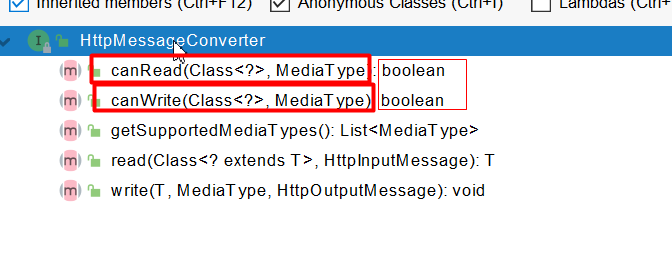
HttpMessageConverter: 看是否支持将 此 Class类型的对象,转为MediaType类型的数据。
例子:Person对象转为JSON。或者 JSON转为Person
2、默认的MessageConverter
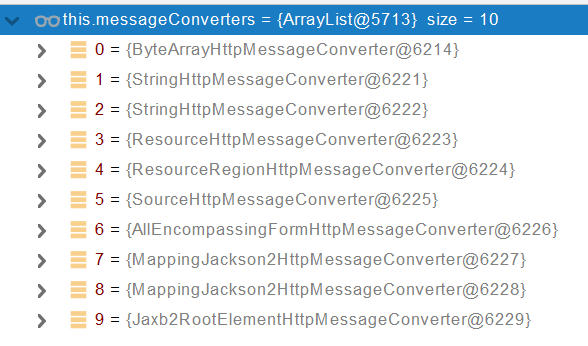
0 - 只支持Byte类型的
1 - String
2 - String
3 - Resource
4 - ResourceRegion
5 - DOMSource.*class * SAXSource.class) \ StAXSource.**class **StreamSource.**class **Source.class
6 - MultiValueMap
7 - true
8 - true
9 - 支持注解方式xml处理的。
最终 MappingJackson2HttpMessageConverter 把对象转为JSON(利用底层的jackson的objectMapper转换的)

2、内容协商
根据客户端接收能力不同,返回不同媒体类型的数据。
1、引入xml依赖
<dependency><groupId>com.fasterxml.jackson.dataformat</groupId><artifactId>jackson-dataformat-xml</artifactId>
</dependency>
2、postman分别测试
只需要改变请求头中Accept字段。Http协议中规定的,告诉服务器本客户端可以接收的数据类型。
[外链图片转存失败,源站可能有防盗链机制,建议将图片保存下来直接上传(img-5vqY4X7b-1650439603421)(C:\Users\ZSW\AppData\Roaming\Typora\typora-user-images\image-20220414154538542.png)]
3、开启浏览器参数方式
为了方便内容协商,开启基于请求参数的内容协商功能。
spring:contentnegotiation:favor-parameter: true #开启请求参数内容协商模式
发请求: http://localhost:8080/test/person?format=json
http://localhost:8080/test/person?format=xml
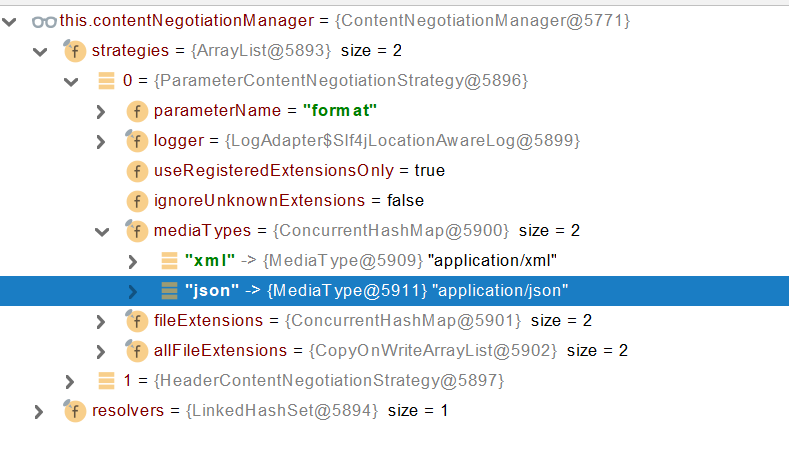
确定客户端接收什么样的内容类型;
1、Parameter策略优先确定是要返回json数据(获取请求头中的format的值)

2、最终进行内容协商返回给客户端json即可。
4、内容协商原理
-
1、判断当前响应头中是否已经有确定的媒体类型。MediaType
-
2、获取客户端(PostMan、浏览器)支持接收的内容类型。(获取客户端Accept请求头字段)【application/xml】
-
- contentNegotiationManager 内容协商管理器 默认使用基于请求头的策略

- HeaderContentNegotiationStrategy 确定客户端可以接收的内容类型

-
3、遍历循环所有当前系统的 MessageConverter,看谁支持操作这个对象(Person)
-
4、找到支持操作Person的converter,把converter支持的媒体类型统计出来。
-
5、客户端需要【application/xml】。服务端能力【10种、json、xml】
-
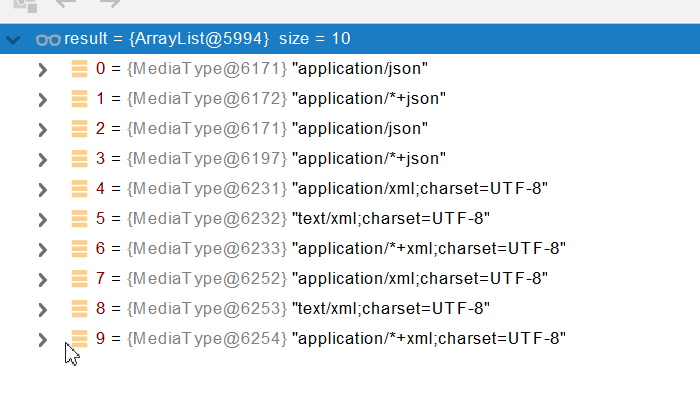 -
6、进行内容协商的最佳匹配媒体类型
-
7、用 支持 将对象转为 最佳匹配媒体类型 的converter。调用它进行转化 。
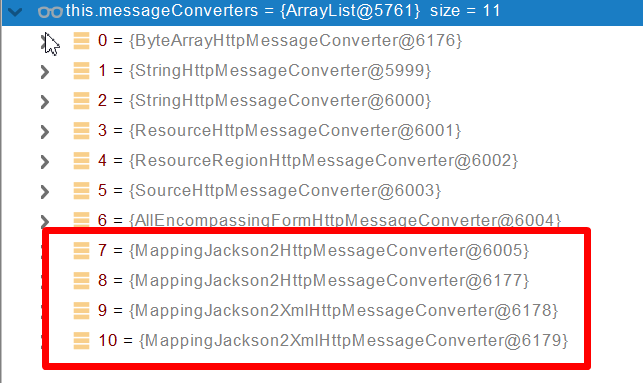
导入了jackson处理xml的包,xml的converter就会自动进来
WebMvcConfigurationSupport
jackson2XmlPresent = ClassUtils.isPresent("com.fasterxml.jackson.dataformat.xml.XmlMapper", classLoader);if (jackson2XmlPresent) {Jackson2ObjectMapperBuilder builder = Jackson2ObjectMapperBuilder.xml();if (this.applicationContext != null) {builder.applicationContext(this.applicationContext);}messageConverters.add(new MappingJackson2XmlHttpMessageConverter(builder.build()));}
5、自定义messageconvert
实现多协议数据兼容。json、xml、x-guigu
0、@ResponseBody 响应数据出去 调用 RequestResponseBodyMethodProcessor 处理
1、Processor 处理方法返回值。通过 MessageConverter 处理
2、所有 MessageConverter 合起来可以支持各种媒体类型数据的操作(读、写)
3、内容协商找到最终的 messageConverter;
SpringMVC的什么功能。一个入口给容器中添加一个 WebMvcConfigurer.
@Beanpublic WebMvcConfigurer webMvcConfigurer(){return new WebMvcConfigurer() {@Overridepublic void extendMessageConverters(List<HttpMessageConverter<?>> converters) {}}}
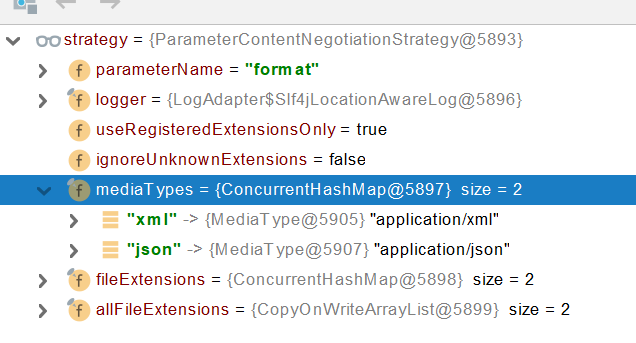
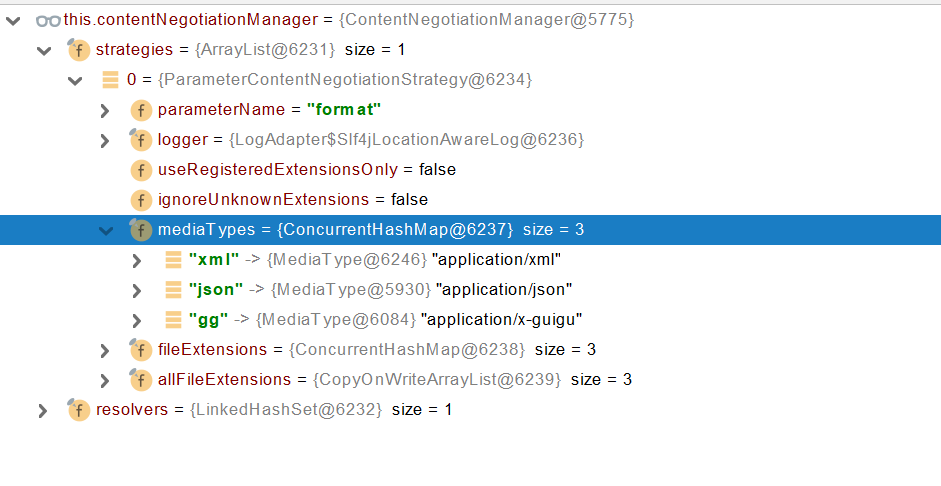
有可能我们添加的自定义的功能会覆盖默认很多功能,导致一些默认的功能失效。
大家考虑,上述功能除了我们完全自定义外?SpringBoot有没有为我们提供基于配置文件的快速修改媒体类型功能?怎么配置呢?【提示:参照SpringBoot官方文档web开发内容协商章节
5、视图解析器与模板引擎
视图解析:SpringBoot默认不支持 JSP,需要引入第三方模板引擎技术实现页面渲染。
1、视图解析
[外链图片转存失败,源站可能有防盗链机制,建议将图片保存下来直接上传(img-EeS7p9Ra-1650439603423)(C:\Users\ZSW\AppData\Roaming\Typora\typora-user-images\image-20220415164313243.png)]
1、目标方法处理的过程中,所有数据都会被放在 ModelAndViewContainer 里面。包括数据和视图地址
2、方法的参数是一个自定义类型对象(从请求参数中确定的),把他重新放在 ModelAndViewContainer
3、任何目标方法执行完成以后都会返回 ModelAndView(数据和视图地址)。
**4、**processDispatchResult 处理派发结果(页面改如何响应)
-
1、render(mv, request, response); 进行页面渲染逻辑
-
- 1、根据方法的String返回值得到 View 对象【定义了页面的渲染逻辑】
-
-
- 1、所有的视图解析器尝试是否能根据当前返回值得到View对象
- 2、得到了 redirect:/main.html --> Thymeleaf new RedirectView()
- 3、ContentNegotiationViewResolver 里面包含了下面所有的视图解析器,内部还是利用下面所有视图解析器得到视图对象。
- 4、view.render(mv.getModelInternal(), request, response); 视图对象调用自定义的render进行页面渲染工作
-
-
-
-
- RedirectView 如何渲染【重定向到一个页面】
- 1、获取目标url地址
- **2、**response.sendRedirect(encodedURL);
-
-
视图解析:
-
- 返回值以 forward: 开始: new InternalResourceView(forwardUrl); --> 转发****request.getRequestDispatcher(path).forward(request, response);
- 返回值以 redirect: 开始: new RedirectView() --》 render就是重定向
- 返回值是普通字符串: new ThymeleafView()—>
自定义视图解析器+自定义视图; 大厂学院。
2、模板引擎thymeleaf
1、简介
Thymeleaf is a modern server-side Java template engine for both web and standalone environments, capable of processing HTML, XML, JavaScript, CSS and even plain text.
现代化、服务端Java模板引擎
2、基本语法
1、表达式
| 表达式名字 | 语法 | 用途 |
|---|---|---|
| 变量取值 | ${…} | 获取请求域、session域、对象等值 |
| 选择变量 | *{…} | 获取上下文对象值 |
| 消息 | #{…} | 获取国际化等值 |
| 链接 | @{…} | 生成链接 |
| 片段表达式 | ~{…} | jsp:include 作用,引入公共页面片段 |
2、字面量
文本值: ‘one text’ , ‘Another one!’ **,…**数字: 0 , 34 , 3.0 , 12.3 **,…**布尔值: true , false
空值: null
变量: one,two,… 变量不能有空格
3、文本操作
字符串拼接: +
变量替换: |The name is ${name}|
4、数学运算
运算符: + , - , * , / , %
5、布尔运算
运算符: and , or
一元运算: ! , not
6、比较运算
比较: > , < , >= , <= ( gt , lt , ge , le **)**等式: == , != ( eq , ne )
7、条件运算
If-then: (if) ? (then)
If-then-else: (if) ? (then) : (else)
Default: (value) ?: (defaultvalue)
8、特殊操作
无操作: _
3、设置属性值
设置单个值
<form action="subscribe.html" th:attr="action=@{/subscribe}"><fieldset><input type="text" name="email" /><input type="submit" value="Subscribe!" th:attr="value=#{subscribe.submit}"/></fieldset>
</form>
设置多个值
<img src="../../images/gtvglogo.png" th:attr="src=@{/images/gtvglogo.png},title=#{logo},alt=#{logo}" />
以上两个的代替写法 th:xxxx
<input type="submit" value="Subscribe!" th:value="#{subscribe.submit}"/>
<form action="subscribe.html" th:action="@{/subscribe}">
所有h5兼容的标签写法
https://www.thymeleaf.org/doc/tutorials/3.0/usingthymeleaf.html#setting-value-to-specific-attributes
4、迭代
<tr th:each="prod : ${prods}"><td th:text="${prod.name}">Onions</td><td th:text="${prod.price}">2.41</td><td th:text="${prod.inStock}? #{true} : #{false}">yes</td>
</tr>
<tr th:each="prod,iterStat : ${prods}" th:class="${iterStat.odd}? 'odd'"><td th:text="${prod.name}">Onions</td><td th:text="${prod.price}">2.41</td><td th:text="${prod.inStock}? #{true} : #{false}">yes</td>
</tr>
5、条件运算
<a href="comments.html"
th:href="@{/product/comments(prodId=${prod.id})}"
th:if="${not #lists.isEmpty(prod.comments)}">view</a>
<div th:switch="${user.role}"><p th:case="'admin'">User is an administrator</p><p th:case="#{roles.manager}">User is a manager</p><p th:case="*">User is some other thing</p>
</div>
6、属性优先级
[外链图片转存失败,源站可能有防盗链机制,建议将图片保存下来直接上传(img-g8zJgjDo-1650439603424)(C:\Users\ZSW\AppData\Roaming\Typora\typora-user-images\image-20220415170217472.png)]
3、thymeleaf使用
1、引入starter
<dependency><groupId>org.springframework.boot</groupId><artifactId>spring-boot-starter-thymeleaf</artifactId></dependency>
2、自动配置好了thymeleaf
@Configuration(proxyBeanMethods = false)
@EnableConfigurationProperties(ThymeleafProperties.class)
@ConditionalOnClass({ TemplateMode.class, SpringTemplateEngine.class })
@AutoConfigureAfter({ WebMvcAutoConfiguration.class, WebFluxAutoConfiguration.class })
public class ThymeleafAutoConfiguration { }
自动配好的策略
-
1、所有thymeleaf的配置值都在 ThymeleafProperties
-
2、配置好了 SpringTemplateEngine
-
3、配好了 ThymeleafViewResolver
-
4、我们只需要直接开发页面
-
public static final String DEFAULT_PREFIX = "classpath:/templates/";public static final String DEFAULT_SUFFIX = ".html"; //xxx.html
3、页面开发
<!DOCTYPE html>
<html lang="en" xmlns:th="http://www.thymeleaf.org">
<head><meta charset="UTF-8"><title>Title</title>
</head>
<body>
<h1 th:text="${msg}">哈哈</h1>
<h2><a href="www.atguigu.com" th:href="${link}">去百度</a> <br/><a href="www.atguigu.com" th:href="@{link}">去百度2</a>
</h2>
</body>
</html>
4、构建后台管理系统
1、创建项目
thymeleaf、web-starter、devtools、lombok
2、静态资源管理
自动配置好,我们只需要把所有静态资源放到 static 文件夹下
3、路径构建
th:action=“@{/login}”
4、模板抽取
th:insert/replace/include
5、页面跳转
@PostMapping("/login")public String main(User user, HttpSession session, Model model){if(StringUtils.hasLength(user.getUserName()) && "123456".equals(user.getPassword())){//把登陆成功的用户保存起来session.setAttribute("loginUser",user);//登录成功重定向到main.html; 重定向防止表单重复提交return "redirect:/main.html";}else {model.addAttribute("msg","账号密码错误");//回到登录页面return "login";}}
6、数据渲染
@GetMapping("/dynamic_table")public String dynamic_table(Model model){//表格内容的遍历List<User> users = Arrays.asList(new User("zhangsan", "123456"),new User("lisi", "123444"),new User("haha", "aaaaa"),new User("hehe ", "aaddd"));model.addAttribute("users",users);return "table/dynamic_table";}
<table class="display table table-bordered" id="hidden-table-info"><thead><tr><th>#</th><th>用户名</th><th>密码</th></tr></thead><tbody><tr class="gradeX" th:each="user,stats:${users}"><td th:text="${stats.count}">Trident</td><td th:text="${user.userName}">Internet</td><td >[[${user.password}]]</td></tr></tbody></table>
6、拦截器
1、Handlerinterceptor接口
/*** 登录检查* 1、配置好拦截器要拦截哪些请求* 2、把这些配置放在容器中*/
@Slf4j
public class LoginInterceptor implements HandlerInterceptor {/*** 目标方法执行之前* @param request* @param response* @param handler* @return* @throws Exception*/@Overridepublic boolean preHandle(HttpServletRequest request, HttpServletResponse response, Object handler) throws Exception {String requestURI = request.getRequestURI();log.info("preHandle拦截的请求路径是{}",requestURI);//登录检查逻辑HttpSession session = request.getSession();Object loginUser = session.getAttribute("loginUser");if(loginUser != null){//放行return true;}//拦截住。未登录。跳转到登录页request.setAttribute("msg","请先登录");
// re.sendRedirect("/");request.getRequestDispatcher("/").forward(request,response);return false;}/*** 目标方法执行完成以后* @param request* @param response* @param handler* @param modelAndView* @throws Exception*/@Overridepublic void postHandle(HttpServletRequest request, HttpServletResponse response, Object handler, ModelAndView modelAndView) throws Exception {log.info("postHandle执行{}",modelAndView);}/*** 页面渲染以后* @param request* @param response* @param handler* @param ex* @throws Exception*/@Overridepublic void afterCompletion(HttpServletRequest request, HttpServletResponse response, Object handler, Exception ex) throws Exception {log.info("afterCompletion执行异常{}",ex);}
}
2、配置拦截器
/*** 1、编写一个拦截器实现HandlerInterceptor接口* 2、拦截器注册到容器中(实现WebMvcConfigurer的addInterceptors)* 3、指定拦截规则【如果是拦截所有,静态资源也会被拦截】*/
@Configuration
public class AdminWebConfig implements WebMvcConfigurer {@Overridepublic void addInterceptors(InterceptorRegistry registry) {registry.addInterceptor(new LoginInterceptor()).addPathPatterns("/**") //所有请求都被拦截包括静态资源.excludePathPatterns("/","/login","/css/**","/fonts/**","/images/**","/js/**"); //放行的请求}
}
3、拦截器原理
1、根据当前请求,找到**HandlerExecutionChain【**可以处理请求的handler以及handler的所有 拦截器】
2、先来顺序执行 所有拦截器的 preHandle方法
- 1、如果当前拦截器prehandler返回为true。则执行下一个拦截器的preHandle
- 2、如果当前拦截器返回为false。直接 倒序执行所有已经执行了的拦截器的 afterCompletion;
3、如果任何一个拦截器返回false。直接跳出不执行目标方法
4、所有拦截器都返回True。执行目标方法
5、倒序执行所有拦截器的postHandle方法。
6、前面的步骤有任何异常都会直接倒序触发 afterCompletion
7、页面成功渲染完成以后,也会倒序触发 afterCompletion
[外链图片转存失败,源站可能有防盗链机制,建议将图片保存下来直接上传(img-76fQITVk-1650439603424)(C:\Users\ZSW\AppData\Roaming\Typora\typora-user-images\image-20220416120125242.png)]
[外链图片转存失败,源站可能有防盗链机制,建议将图片保存下来直接上传(img-pPNWCvWC-1650439603424)(C:\Users\ZSW\AppData\Roaming\Typora\typora-user-images\image-20220416120134853.png)]
老师举得例子中,注意一下为什么会拦截两次,因为使用了重定向,所以会导致再一次的去进行拦截。
7、文件上传
一个别人的项目
https://github.com/HaiTang-8/File-Upload/tree/master
1、页面表单
<form method="post" action="/upload" enctype="multipart/form-data"><input type="file" name="file"><br><input type="submit" value="提交">
</form>
2、文件上传代码
/*** MultipartFile 自动封装上传过来的文件* @param email* @param username* @param headerImg* @param photos* @return*/@PostMapping("/upload")public String upload(@RequestParam("email") String email,@RequestParam("username") String username,@RequestPart("headerImg") MultipartFile headerImg,@RequestPart("photos") MultipartFile[] photos) throws IOException {log.info("上传的信息:email={},username={},headerImg={},photos={}",email,username,headerImg.getSize(),photos.length);if(!headerImg.isEmpty()){//保存到文件服务器,OSS服务器String originalFilename = headerImg.getOriginalFilename();headerImg.transferTo(new File("H:\\cache\\"+originalFilename));}if(photos.length > 0){for (MultipartFile photo : photos) {if(!photo.isEmpty()){String originalFilename = photo.getOriginalFilename();photo.transferTo(new File("H:\\cache\\"+originalFilename));}}}return "main";}3、自动配置原理
**文件上传自动配置类-MultipartAutoConfiguration-**MultipartProperties
-
自动配置好了 StandardServletMultipartResolver 【文件上传解析器】
-
原理步骤
-
- 1、请求进来使用文件上传解析器判断(isMultipart)并封装(resolveMultipart,返回MultipartHttpServletRequest)文件上传请求
- 2、参数解析器来解析请求中的文件内容封装成MultipartFile
- **3、将request中文件信息封装为一个Map;**MultiValueMap<String, MultipartFile>
FileCopyUtils。实现文件流的拷贝
@PostMapping("/upload")public String upload(@RequestParam("email") String email,@RequestParam("username") String username,@RequestPart("headerImg") MultipartFile headerImg,@RequestPart("photos") MultipartFile[] photos)
[外链图片转存失败,源站可能有防盗链机制,建议将图片保存下来直接上传(img-wsCZDP3G-1650439603425)(C:\Users\ZSW\AppData\Roaming\Typora\typora-user-images\image-20220416145146549.png)]
8、异常处理
1、默认规则
- 默认情况下,Spring Boot提供
/error处理所有错误的映射 - 对于机器客户端,它将生成JSON响应,其中包含错误,HTTP状态和异常消息的详细信息。对于浏览器客户端,响应一个“ whitelabel”错误视图,以HTML格式呈现相同的数据
[外链图片转存失败,源站可能有防盗链机制,建议将图片保存下来直接上传(img-uj6FX2So-1650439603425)(C:\Users\ZSW\AppData\Roaming\Typora\typora-user-images\image-20220416153609125.png)]
要对其进行自定义,添加**View**解析为**error**
- 要完全替换默认行为,可以实现
ErrorController并注册该类型的Bean定义,或添加ErrorAttributes类型的组件以使用现有机制但替换其内容。 - error/下的4xx,5xx页面会被自动解析;
[外链图片转存失败,源站可能有防盗链机制,建议将图片保存下来直接上传(img-iX8xrOCN-1650439603425)(C:\Users\ZSW\AppData\Roaming\Typora\typora-user-images\image-20220416153647292.png)]
2、定制错误处理逻辑
-
自定义错误页
-
- error/404.html error/5xx.html;有精确的错误状态码页面就匹配精确,没有就找 4xx.html;如果都没有就触发白页
-
@ControllerAdvice+@ExceptionHandler处理全局异常;底层是 ExceptionHandlerExceptionResolver 支持的
-
@ResponseStatus+自定义异常 ;底层是 ResponseStatusExceptionResolver ,把responsestatus注解的信息底层调用 response.sendError(statusCode, resolvedReason);tomcat发送的/error
-
Spring底层的异常,如 参数类型转换异常;DefaultHandlerExceptionResolver 处理框架底层的异常。
-
- response.sendError(HttpServletResponse.SC_BAD_REQUEST, ex.getMessage());
[外链图片转存失败,源站可能有防盗链机制,建议将图片保存下来直接上传(img-KzmpKIUE-1650439603425)(C:\Users\ZSW\AppData\Roaming\Typora\typora-user-images\image-20220416153707298.png)]
- 自定义实现 HandlerExceptionResolver 处理异常;可以作为默认的全局异常处理规则
[外链图片转存失败,源站可能有防盗链机制,建议将图片保存下来直接上传(img-HdrtaHlp-1650439603426)(C:\Users\ZSW\AppData\Roaming\Typora\typora-user-images\image-20220416153722892.png)]
-
ErrorViewResolver 实现自定义处理异常;
-
- response.sendError 。error请求就会转给controller
- 你的异常没有任何人能处理。tomcat底层 response.sendError。error请求就会转给controller
- basicErrorController 要去的页面地址是 ErrorViewResolver ;
3、异常处理自动配置原理
-
ErrorMvcAutoConfiguration 自动配置异常处理规则
-
- 容器中的组件:类型:DefaultErrorAttributes -> id:errorAttributes
-
-
- public class DefaultErrorAttributes implements ErrorAttributes, HandlerExceptionResolver
- DefaultErrorAttributes:定义错误页面中可以包含哪些数据。
-
[外链图片转存失败,源站可能有防盗链机制,建议将图片保存下来直接上传(img-c7rgZaFb-1650439603426)(C:\Users\ZSW\AppData\Roaming\Typora\typora-user-images\image-20220416153825570.png)]
-
- **容器中的组件:类型:**BasicErrorController --> id:basicErrorController(json+白页 适配响应)
-
-
- 处理默认 /error 路径的请求;页面响应 new ModelAndView(“error”, model);
- 容器中有组件 View->id是error;(响应默认错误页)
- 容器中放组件 BeanNameViewResolver(视图解析器);按照返回的视图名作为组件的id去容器中找View对象。
-
-
- **容器中的组件:**类型:**DefaultErrorViewResolver -> id:**conventionErrorViewResolver
-
-
- 如果发生错误,会以HTTP的状态码 作为视图页地址(viewName),找到真正的页面
- error/404、5xx.html
-
如果想要返回页面;就会找error视图【StaticView】。(默认是一个白页)
[外链图片转存失败,源站可能有防盗链机制,建议将图片保存下来直接上传(img-hK6x2qMH-1650439603426)(C:\Users\ZSW\AppData\Roaming\Typora\typora-user-images\image-20220416153846433.png)]
4、异常处理步骤流程
1、执行目标方法,目标方法运行期间有任何异常都会被catch、而且标志当前请求结束;并且用 dispatchException
2、进入视图解析流程(页面渲染?)
processDispatchResult(processedRequest, response, mappedHandler, mv, dispatchException);
3、mv = processHandlerException;处理handler发生的异常,处理完成返回ModelAndView;
-
1、遍历所有的 handlerExceptionResolvers,看谁能处理当前异常【HandlerExceptionResolver处理器异常解析器】
-

-
系统默认的 异常解析器;
-
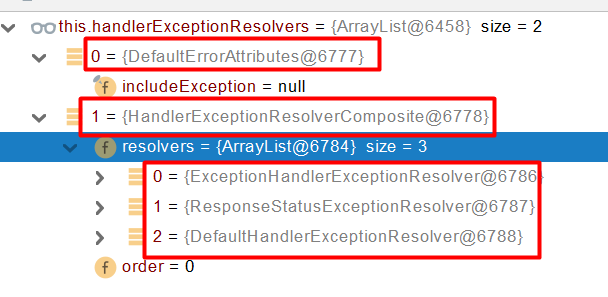
-
- 1、DefaultErrorAttributes先来处理异常。把异常信息保存到rrequest域,并且返回null;
- 2、默认没有任何人能处理异常,所以异常会被抛出
-
-
- 1、如果没有任何人能处理最终底层就会发送 /error 请求。会被底层的BasicErrorController处理
- 2、解析错误视图;遍历所有的 ErrorViewResolver 看谁能解析。

- 3、默认的 DefaultErrorViewResolver ,作用是把响应状态码作为错误页的地址,error/500.html
- 4、模板引擎最终响应这个页面 error/500.html
-
9、Web原生组件注入
1、使用serveletAPI
@ServletComponentScan(basePackages = “com.atguigu.admin”) :指定原生Servlet组件都放在那里
@WebServlet(urlPatterns = “/my”):效果:直接响应,没有经过Spring的拦截器?
@WebFilter(urlPatterns={“/css/*”,“/images/*”})
@WebListener
推荐可以这种方式;
扩展:DispatchServlet 如何注册进来
- 容器中自动配置了 DispatcherServlet 属性绑定到 WebMvcProperties;对应的配置文件配置项是 spring.mvc。
- 通过 ServletRegistrationBean 把 DispatcherServlet 配置进来。
- 默认映射的是 / 路径。
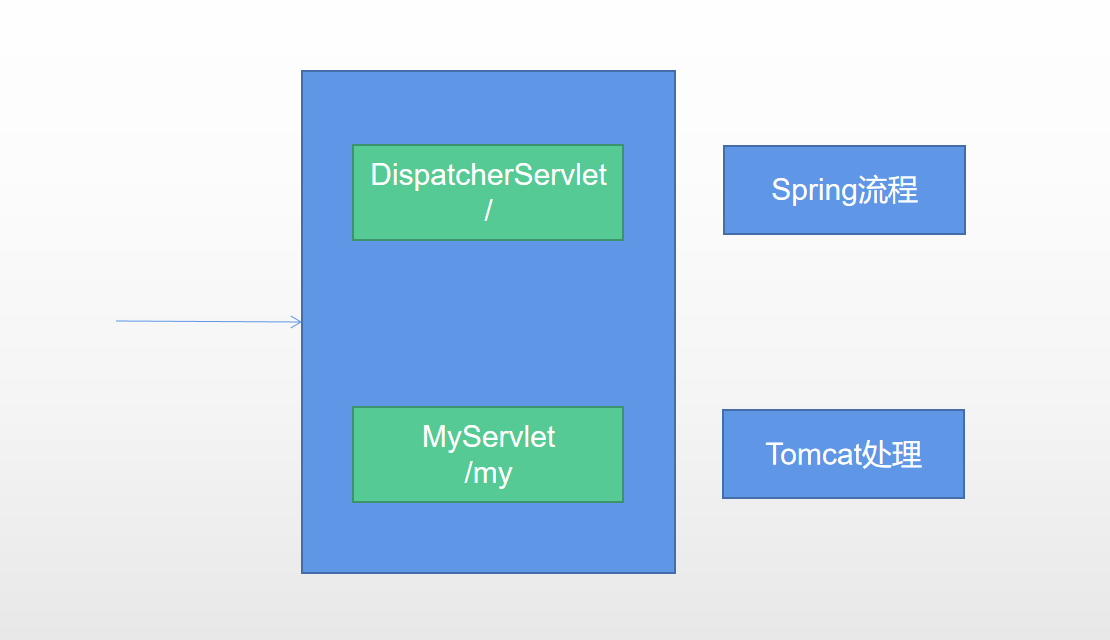
Tomcat-Servlet;
多个Servlet都能处理到同一层路径,精确优选原则
A: /my/
B: /my/1
2、使用registrationBean
ServletRegistrationBean`, `FilterRegistrationBean`, and `ServletListenerRegistrationBean
@Configuration
public class MyRegistConfig {@Beanpublic ServletRegistrationBean myServlet(){MyServlet myServlet = new MyServlet();return new ServletRegistrationBean(myServlet,"/my","/my02");}@Beanpublic FilterRegistrationBean myFilter(){MyFilter myFilter = new MyFilter();
// return new FilterRegistrationBean(myFilter,myServlet());FilterRegistrationBean filterRegistrationBean = new FilterRegistrationBean(myFilter);filterRegistrationBean.setUrlPatterns(Arrays.asList("/my","/css/*"));return filterRegistrationBean;}@Beanpublic ServletListenerRegistrationBean myListener(){MySwervletContextListener mySwervletContextListener = new MySwervletContextListener();return new ServletListenerRegistrationBean(mySwervletContextListener);}
}
10、嵌入式servlet容器
1、切换嵌入式servlet容器
-
默认支持的webServer
-
Tomcat,Jetty, orUndertowServletWebServerApplicationContext 容器启动寻找ServletWebServerFactory 并引导创建服务器
-
切换服务器

<dependency><groupId>org.springframework.boot</groupId><artifactId>spring-boot-starter-web</artifactId><exclusions><exclusion><groupId>org.springframework.boot</groupId><artifactId>spring-boot-starter-tomcat</artifactId></exclusion></exclusions>
</dependency>
-
原理
-
- SpringBoot应用启动发现当前是Web应用。web场景包-导入tomcat
- web应用会创建一个web版的ioc容器
ServletWebServerApplicationContext ServletWebServerApplicationContext启动的时候寻找**ServletWebServerFactory**``(Servlet 的web服务器工厂---> Servlet 的web服务器)- SpringBoot底层默认有很多的WebServer工厂;
TomcatServletWebServerFactory,JettyServletWebServerFactory, orUndertowServletWebServerFactory 底层直接会有一个自动配置类。ServletWebServerFactoryAutoConfigurationServletWebServerFactoryAutoConfiguration导入了ServletWebServerFactoryConfiguration(配置类)ServletWebServerFactoryConfiguration 配置类 根据动态判断系统中到底导入了那个Web服务器的包。(默认是web-starter导入tomcat包),容器中就有 TomcatServletWebServerFactoryTomcatServletWebServerFactory 创建出Tomcat服务器并启动;TomcatWebServer 的构造器拥有初始化方法initialize---this.tomcat.start();内嵌服务器,就是手动把启动服务器的代码调用(tomcat核心jar包存在)
2、地址servlet容器
-
实现 WebServerFactoryCustomizer
-
- 把配置文件的值和
**ServletWebServerFactory 进行绑定**
- 把配置文件的值和
-
修改配置文件 server.xxx
-
直接自定义 ConfigurableServletWebServerFactory
xxxxxCustomizer:定制化器,可以改变xxxx的默认规则
import org.springframework.boot.web.server.WebServerFactoryCustomizer;
import org.springframework.boot.web.servlet.server.ConfigurableServletWebServerFactory;
import org.springframework.stereotype.Component;@Component
public class CustomizationBean implements WebServerFactoryCustomizer<ConfigurableServletWebServerFactory> {@Overridepublic void customize(ConfigurableServletWebServerFactory server) {server.setPort(9000);}}
11、定制化原理
1、定制化的常见方法
- 修改配置文件;
- xxxxxCustomizer;
- 编写自定义的配置类 xxxConfiguration;+ @Bean替换、增加容器中默认组件;视图解析器
- Web应用 编写一个配置类实现 WebMvcConfigurer 即可定制化web功能;+ @Bean给容器中再扩展一些组件
@Configuration
public class AdminWebConfig implements WebMvcConfigurer
-
@EnableWebMvc + WebMvcConfigurer —— @Bean 可以全面接管SpringMVC,所有规则全部自己重新配置; 实现定制和扩展功能
-
- 原理
- 1、WebMvcAutoConfiguration 默认的SpringMVC的自动配置功能类。静态资源、欢迎页…
- 2、一旦使用 @EnableWebMvc 、。会 @Import(DelegatingWebMvcConfiguration.class)
- 3、DelegatingWebMvcConfiguration 的 作用,只保证SpringMVC最基本的使用
-
-
- 把所有系统中的 WebMvcConfigurer 拿过来。所有功能的定制都是这些 WebMvcConfigurer 合起来一起生效
- 自动配置了一些非常底层的组件。RequestMappingHandlerMapping、这些组件依赖的组件都是从容器中获取
- public class DelegatingWebMvcConfiguration extends WebMvcConfigurationSupport
-
-
- 4、WebMvcAutoConfiguration 里面的配置要能生效 必须 @ConditionalOnMissingBean(WebMvcConfigurationSupport.class)
- 5、@EnableWebMvc 导致了 WebMvcAutoConfiguration 没有生效。
-
… …
2、原理分析套路
场景starter - xxxxAutoConfiguration - 导入xxx组件 - 绑定xxxProperties – 绑定配置文件项
3、数据访问
1、数据源的自动配置
1、导入jdbc
<dependency><groupId>org.springframework.boot</groupId><artifactId>spring-boot-starter-data-jdbc</artifactId></dependency>默认版本:<mysql.version>8.0.22</mysql.version><dependency><groupId>mysql</groupId><artifactId>mysql-connector-java</artifactId>
<!-- <version>5.1.49</version>--></dependency>
想要修改版本
1、直接依赖引入具体版本(maven的就近依赖原则)
2、重新声明版本(maven的属性的就近优先原则)<properties><java.version>1.8</java.version><mysql.version>5.1.49</mysql.version></properties>
2、分析自动配置
-
DataSourceAutoConfiguration : 数据源的自动配置
-
- 修改数据源相关的配置:spring.datasource
- 数据库连接池的配置,是自己容器中没有DataSource才自动配置的
- 底层配置好的连接池是:HikariDataSource
@Configuration(proxyBeanMethods = false)@Conditional(PooledDataSourceCondition.class)@ConditionalOnMissingBean({ DataSource.class, XADataSource.class })@Import({ DataSourceConfiguration.Hikari.class, DataSourceConfiguration.Tomcat.class,DataSourceConfiguration.Dbcp2.class, DataSourceConfiguration.OracleUcp.class,DataSourceConfiguration.Generic.class, DataSourceJmxConfiguration.class })protected static class PooledDataSourceConfiguration
-
DataSourceTransactionManagerAutoConfiguration: 事务管理器的自动配置
-
JdbcTemplateAutoConfiguration: JdbcTemplate的自动配置,可以来对数据库进行crud
-
- 可以修改这个配置项@ConfigurationProperties(prefix = “spring.jdbc”) 来修改JdbcTemplate
- @Bean@Primary JdbcTemplate;容器中有这个组件
-
JndiDataSourceAutoConfiguration: jndi的自动配置
-
XADataSourceAutoConfiguration: 分布式事务相关的
3、修改配置项
spring:datasource:url: jdbc:mysql://localhost:3306/db_accountusername: rootpassword: 123456driver-class-name: com.mysql.jdbc.Driver
4、测试
@Slf4j
@SpringBootTest
class Boot05WebAdminApplicationTests {@AutowiredJdbcTemplate jdbcTemplate;@Testvoid contextLoads() {// jdbcTemplate.queryForObject("select * from account_tbl")
// jdbcTemplate.queryForList("select * from account_tbl",)Long aLong = jdbcTemplate.queryForObject("select count(*) from account_tbl", Long.class);log.info("记录总数:{}",aLong);}}
2、使用druid数据源
1、druid官方github地址
https://github.com/alibaba/druid
整合第三方技术的两种方式
- 自定义
- 找starter
2、自定义方式
创建数据源
<dependency><groupId>com.alibaba</groupId><artifactId>druid</artifactId><version>1.1.17</version></dependency><bean id="dataSource" class="com.alibaba.druid.pool.DruidDataSource"destroy-method="close"><property name="url" value="${jdbc.url}" /><property name="username" value="${jdbc.username}" /><property name="password" value="${jdbc.password}" /><property name="maxActive" value="20" /><property name="initialSize" value="1" /><property name="maxWait" value="60000" /><property name="minIdle" value="1" /><property name="timeBetweenEvictionRunsMillis" value="60000" /><property name="minEvictableIdleTimeMillis" value="300000" /><property name="testWhileIdle" value="true" /><property name="testOnBorrow" value="false" /><property name="testOnReturn" value="false" /><property name="poolPreparedStatements" value="true" /><property name="maxOpenPreparedStatements" value="20" />StatViewServlet
StatViewServlet的用途包括:
- 提供监控信息展示的html页面
- 提供监控信息的JSON API
<servlet><servlet-name>DruidStatView</servlet-name><servlet-class>com.alibaba.druid.support.http.StatViewServlet</servlet-class></servlet><servlet-mapping><servlet-name>DruidStatView</servlet-name><url-pattern>/druid/*</url-pattern></servlet-mapping>
statFilter
用于统计监控信息;如SQL监控、URI监控
需要给数据源中配置如下属性;可以允许多个filter,多个用,分割;如:<property name="filters" value="stat,slf4j" />
系统中所有filter:
| 别名 | Filter类名 |
|---|---|
| default | com.alibaba.druid.filter.stat.StatFilter |
| stat | com.alibaba.druid.filter.stat.StatFilter |
| mergeStat | com.alibaba.druid.filter.stat.MergeStatFilter |
| encoding | com.alibaba.druid.filter.encoding.EncodingConvertFilter |
| log4j | com.alibaba.druid.filter.logging.Log4jFilter |
| log4j2 | com.alibaba.druid.filter.logging.Log4j2Filter |
| slf4j | com.alibaba.druid.filter.logging.Slf4jLogFilter |
| commonlogging | com.alibaba.druid.filter.logging.CommonsLogFilter |
慢SQL记录配置
<bean id="stat-filter" class="com.alibaba.druid.filter.stat.StatFilter"><property name="slowSqlMillis" value="10000" /><property name="logSlowSql" value="true" />
</bean>使用 slowSqlMillis 定义慢SQL的时长
3、使用官方的starter方式
1、引入druid-starter
<dependency><groupId>com.alibaba</groupId><artifactId>druid-spring-boot-starter</artifactId><version>1.1.17</version></dependency>
2、分析自动配置
- 扩展配置项 spring.datasource.druid
- DruidSpringAopConfiguration.class, 监控SpringBean的;配置项:spring.datasource.druid.aop-patterns
- DruidStatViewServletConfiguration.class, 监控页的配置:spring.datasource.druid.stat-view-servlet;默认开启
- DruidWebStatFilterConfiguration.class, web监控配置;spring.datasource.druid.web-stat-filter;默认开启
- DruidFilterConfiguration.class}) 所有Druid自己filter的配置
private static final String FILTER_STAT_PREFIX = "spring.datasource.druid.filter.stat";private static final String FILTER_CONFIG_PREFIX = "spring.datasource.druid.filter.config";private static final String FILTER_ENCODING_PREFIX = "spring.datasource.druid.filter.encoding";private static final String FILTER_SLF4J_PREFIX = "spring.datasource.druid.filter.slf4j";private static final String FILTER_LOG4J_PREFIX = "spring.datasource.druid.filter.log4j";private static final String FILTER_LOG4J2_PREFIX = "spring.datasource.druid.filter.log4j2";private static final String FILTER_COMMONS_LOG_PREFIX = "spring.datasource.druid.filter.commons-log";private static final String FILTER_WALL_PREFIX = "spring.datasource.druid.filter.wall";
3、配置实例
spring:datasource:url: jdbc:mysql://localhost:3306/db_accountusername: rootpassword: 123456driver-class-name: com.mysql.jdbc.Driverdruid:aop-patterns: com.atguigu.admin.* #监控SpringBeanfilters: stat,wall # 底层开启功能,stat(sql监控),wall(防火墙)stat-view-servlet: # 配置监控页功能enabled: truelogin-username: adminlogin-password: adminresetEnable: falseweb-stat-filter: # 监控webenabled: trueurlPattern: /*exclusions: '*.js,*.gif,*.jpg,*.png,*.css,*.ico,/druid/*'filter:stat: # 对上面filters里面的stat的详细配置slow-sql-millis: 1000logSlowSql: trueenabled: truewall:enabled: trueconfig:drop-table-allow: false
SpringBoot配置示例
https://github.com/alibaba/druid/tree/master/druid-spring-boot-starter
配置项列表https://github.com/alibaba/druid/wiki/DruidDataSource%E9%85%8D%E7%BD%AE%E5%B1%9E%E6%80%A7%E5%88%97%E8%A1%A8
3、整合mybatis
https://github.com/mybatis
starter
SpringBoot官方的Starter:spring-boot-starter-*
第三方的: *-spring-boot-starter
<dependency><groupId>org.mybatis.spring.boot</groupId><artifactId>mybatis-spring-boot-starter</artifactId><version>2.1.4</version></dependency>
1、配置模式
- 全局配置文件
- SqlSessionFactory: 自动配置好了
- SqlSession:自动配置了 SqlSessionTemplate 组合了SqlSession
- @Import(AutoConfiguredMapperScannerRegistrar.class);
- Mapper: 只要我们写的操作MyBatis的接口标准了 @Mapper 就会被自动扫描进来
@EnableConfigurationProperties(MybatisProperties.class) : MyBatis配置项绑定类。
@AutoConfigureAfter({ DataSourceAutoConfiguration.class, MybatisLanguageDriverAutoConfiguration.class })
public class MybatisAutoConfiguration{}@ConfigurationProperties(prefix = "mybatis")
public class MybatisProperties
可以修改配置文件中 mybatis 开始的所有;
# 配置mybatis规则
mybatis:config-location: classpath:mybatis/mybatis-config.xml #全局配置文件位置mapper-locations: classpath:mybatis/mapper/*.xml #sql映射文件位置Mapper接口--->绑定Xml
<?xml version="1.0" encoding="UTF-8" ?>
<!DOCTYPE mapperPUBLIC "-//mybatis.org//DTD Mapper 3.0//EN""http://mybatis.org/dtd/mybatis-3-mapper.dtd">
<mapper namespace="com.atguigu.admin.mapper.AccountMapper">
<!-- public Account getAcct(Long id); --><select id="getAcct" resultType="com.atguigu.admin.bean.Account">select * from account_tbl where id=#{id}</select>
</mapper>
配置 private Configuration configuration; mybatis.configuration下面的所有,就是相当于改mybatis全局配置文件中的值
# 配置mybatis规则
mybatis:
# config-location: classpath:mybatis/mybatis-config.xmlmapper-locations: classpath:mybatis/mapper/*.xmlconfiguration:map-underscore-to-camel-case: true可以不写全局;配置文件,所有全局配置文件的配置都放在configuration配置项中即可
- 导入mybatis官方starter
- 编写mapper接口。标准@Mapper注解
- 编写sql映射文件并绑定mapper接口
- 在application.yaml中指定Mapper配置文件的位置,以及指定全局配置文件的信息 (建议;配置在mybatis.configuration)
注意
mybatis默认不开启驼峰命名的规则,需要自己去配置
可以再配置文件中进行配置,或者起别名。
2、注解模式
@Mapper
public interface CityMapper {@Select("select * from city where id=#{id}")public City getById(Long id);public void insert(City city);}3、混合模式
@Mapper
public interface CityMapper {@Select("select * from city where id=#{id}")public City getById(Long id);public void insert(City city);}
最佳实战:
- 引入mybatis-starter
- 配置application.yaml中,指定mapper-location位置即可
- 编写Mapper接口并标注@Mapper注解
- 简单方法直接注解方式
- 复杂方法编写mapper.xml进行绑定映射
- @MapperScan(“com.atguigu.admin.mapper”) 简化,其他的接口就可以不用标注@Mapper注解
4、整合mybatis-plus
1、什么是mybatis-plus
MyBatis-Plus(简称 MP)是一个 MyBatis 的增强工具,在 MyBatis 的基础上只做增强不做改变,为简化开发、提高效率而生。
mybatis plus 官网
建议安装 MybatisX 插件
2、整合
<dependency><groupId>com.baomidou</groupId><artifactId>mybatis-plus-boot-starter</artifactId><version>3.4.1</version></dependency>
自动配置
- MybatisPlusAutoConfiguration 配置类,MybatisPlusProperties 配置项绑定。mybatis-plus:xxx 就是对****mybatis-plus的定制
- SqlSessionFactory 自动配置好。底层是容器中默认的数据源
- **mapperLocations 自动配置好的。有默认值。*classpath*:/mapper/*/*.xml;任意包的类路径下的所有mapper文件夹下任意路径下的所有xml都是sql映射文件。 建议以后sql映射文件,放在 mapper下
- 容器中也自动配置好了 SqlSessionTemplate
- @Mapper 标注的接口也会被自动扫描;建议直接 @MapperScan(“com.atguigu.admin.mapper”) 批量扫描就行
优点:
- 只需要我们的Mapper继承 BaseMapper 就可以拥有crud能力
3、crud功能
@GetMapping("/user/delete/{id}")public String deleteUser(@PathVariable("id") Long id,@RequestParam(value = "pn",defaultValue = "1")Integer pn,RedirectAttributes ra){userService.removeById(id);ra.addAttribute("pn",pn);return "redirect:/dynamic_table";}@GetMapping("/dynamic_table")public String dynamic_table(@RequestParam(value="pn",defaultValue = "1") Integer pn,Model model){//表格内容的遍历
// response.sendError
// List<User> users = Arrays.asList(new User("zhangsan", "123456"),
// new User("lisi", "123444"),
// new User("haha", "aaaaa"),
// new User("hehe ", "aaddd"));
// model.addAttribute("users",users);
//
// if(users.size()>3){
// throw new UserTooManyException();
// }//从数据库中查出user表中的用户进行展示//构造分页参数Page<User> page = new Page<>(pn, 2);//调用page进行分页Page<User> userPage = userService.page(page, null);// userPage.getRecords()
// userPage.getCurrent()
// userPage.getPages()model.addAttribute("users",userPage);return "table/dynamic_table";}
@Service
public class UserServiceImpl extends ServiceImpl<UserMapper,User> implements UserService {}public interface UserService extends IService<User> {}
5、nosql
1、redis自动配置
Redis 是一个开源(BSD许可)的,内存中的数据结构存储系统,它可以用作数据库、缓存和消息中间件。 它支持多种类型的数据结构,如 字符串(strings), 散列(hashes), 列表(lists), 集合(sets), 有序集合(sorted sets) 与范围查询, bitmaps, hyperloglogs 和 地理空间(geospatial) 索引半径查询。 Redis 内置了 复制(replication),LUA脚本(Lua scripting), LRU驱动事件(LRU eviction),事务(transactions) 和不同级别的 磁盘持久化(persistence), 并通过 Redis哨兵(Sentinel)和自动 分区(Cluster)提供高可用性(high availability)。
<dependency><groupId>org.springframework.boot</groupId><artifactId>spring-boot-starter-data-redis</artifactId></dependency>
自动配置:
- RedisAutoConfiguration 自动配置类。RedisProperties 属性类 --> spring.redis.xxx是对redis的配置
- 连接工厂是准备好的。LettuceConnectionConfiguration、JedisConnectionConfiguration
- 自动注入了RedisTemplate<Object, Object> : xxxTemplate;
- 自动注入了StringRedisTemplate;k:v都是String
- key:value
- 底层只要我们使用 **StringRedisTemplate、**RedisTemplate就可以操作redis
redis环境搭建
1、阿里云按量付费redis。经典网络
2、申请redis的公网连接地址
3、修改白名单 允许0.0.0.0/0 访问
2、redistemplate与lettuce
@Testvoid testRedis(){ValueOperations<String, String> operations = redisTemplate.opsForValue();operations.set("hello","world");String hello = operations.get("hello");System.out.println(hello);}
3、切换着jedis
<dependency><groupId>org.springframework.boot</groupId><artifactId>spring-boot-starter-data-redis</artifactId></dependency><!-- 导入jedis--><dependency><groupId>redis.clients</groupId><artifactId>jedis</artifactId></dependency>
spring:redis:host: r-bp1nc7reqesxisgxpipd.redis.rds.aliyuncs.comport: 6379password: lfy:Lfy123456client-type: jedisjedis:pool:max-active: 10
4、单元测试
1、JUnit5的变化
Spring Boot 2.2.0 版本开始引入 JUnit 5 作为单元测试默认库
作为最新版本的JUnit框架,JUnit5与之前版本的Junit框架有很大的不同。由三个不同子项目的几个不同模块组成。
JUnit 5 = JUnit Platform + JUnit Jupiter + JUnit Vintage
JUnit Platform: Junit Platform是在JVM上启动测试框架的基础,不仅支持Junit自制的测试引擎,其他测试引擎也都可以接入。
JUnit Jupiter: JUnit Jupiter提供了JUnit5的新的编程模型,是JUnit5新特性的核心。内部 包含了一个测试引擎,用于在Junit Platform上运行。
JUnit Vintage: 由于JUint已经发展多年,为了照顾老的项目,JUnit Vintage提供了兼容JUnit4.x,Junit3.x的测试引擎。
[外链图片转存失败,源站可能有防盗链机制,建议将图片保存下来直接上传(img-E9jpYdif-1650439603428)(C:\Users\ZSW\AppData\Roaming\Typora\typora-user-images\image-20220419163122080.png)]
注意:
SpringBoot 2.4 以上版本移除了默认对 Vintage 的依赖。如果需要兼容junit4需要自行引入(不能使用junit4的功能 @Test**)**
JUnit 5’s Vintage Engine Removed from **spring-boot-starter-test,如果需要继续兼容junit4需要自行引入vintage**
<dependency><groupId>org.junit.vintage</groupId><artifactId>junit-vintage-engine</artifactId><scope>test</scope><exclusions><exclusion><groupId>org.hamcrest</groupId><artifactId>hamcrest-core</artifactId></exclusion></exclusions>
</dependency>
<dependency><groupId>org.springframework.boot</groupId><artifactId>spring-boot-starter-test</artifactId><scope>test</scope>
</dependency>
@SpringBootTest
class Boot05WebAdminApplicationTests {@Testvoid contextLoads() {}
}
以前:
@SpringBootTest + @RunWith(SpringTest.class)
SpringBoot整合Junit以后。
- 编写测试方法:@Test标注(注意需要使用junit5版本的注解)
- Junit类具有Spring的功能,@Autowired、比如 @Transactional 标注测试方法,测试完成后自动回滚
2、常用注解
JUnit5的注解与JUnit4的注解有所变化
https://junit.org/junit5/docs/current/user-guide/#writing-tests-annotations
- **@Test 😗*表示方法是测试方法。但是与JUnit4的@Test不同,他的职责非常单一不能声明任何属性,拓展的测试将会由Jupiter提供额外测试
- **@ParameterizedTest 😗*表示方法是参数化测试,下方会有详细介绍
- **@RepeatedTest 😗*表示方法可重复执行,下方会有详细介绍
- **@DisplayName 😗*为测试类或者测试方法设置展示名称
- **@BeforeEach 😗*表示在每个单元测试之前执行
- **@AfterEach 😗*表示在每个单元测试之后执行
- **@BeforeAll 😗*表示在所有单元测试之前执行
- **@AfterAll 😗*表示在所有单元测试之后执行
- **@Tag 😗*表示单元测试类别,类似于JUnit4中的@Categories
- **@Disabled 😗*表示测试类或测试方法不执行,类似于JUnit4中的@Ignore
- **@Timeout 😗*表示测试方法运行如果超过了指定时间将会返回错误
- **@ExtendWith 😗*为测试类或测试方法提供扩展类引用
import org.junit.jupiter.api.Test; //注意这里使用的是jupiter的Test注解!!public class TestDemo {@Test@DisplayName("第一次测试")public void firstTest() {System.out.println("hello world");}
3、断言
断言(assertions)是测试方法中的核心部分,用来对测试需要满足的条件进行验证。这些断言方法都是 org.junit.jupiter.api.Assertions 的静态方法。JUnit 5 内置的断言可以分成如下几个类别:
检查业务逻辑返回的数据是否合理。
所有的测试运行结束以后,会有一个详细的测试报告;
1、简单断言
用来对单个值进行简单的验证。如:
| 方法 | 说明 |
|---|---|
| assertEquals | 判断两个对象或两个原始类型是否相等 |
| assertNotEquals | 判断两个对象或两个原始类型是否不相等 |
| assertSame | 判断两个对象引用是否指向同一个对象 |
| assertNotSame | 判断两个对象引用是否指向不同的对象 |
| assertTrue | 判断给定的布尔值是否为 true |
| assertFalse | 判断给定的布尔值是否为 false |
| assertNull | 判断给定的对象引用是否为 null |
| assertNotNull | 判断给定的对象引用是否不为 null |
@Test
@DisplayName("simple assertion")
public void simple() {assertEquals(3, 1 + 2, "simple math");assertNotEquals(3, 1 + 1);assertNotSame(new Object(), new Object());Object obj = new Object();assertSame(obj, obj);assertFalse(1 > 2);assertTrue(1 < 2);assertNull(null);assertNotNull(new Object());
}
2、数组断言
通过 assertArrayEquals 方法来判断两个对象或原始类型的数组是否相等
@Test
@DisplayName("array assertion")
public void array() {assertArrayEquals(new int[]{1, 2}, new int[] {1, 2});
}
3、组合断言
assertAll 方法接受多个 org.junit.jupiter.api.Executable 函数式接口的实例作为要验证的断言,可以通过 lambda 表达式很容易的提供这些断言
@Test
@DisplayName("assert all")
public void all() {assertAll("Math",() -> assertEquals(2, 1 + 1),() -> assertTrue(1 > 0));
}
4、异常断言
在JUnit4时期,想要测试方法的异常情况时,需要用**@Rule注解的ExpectedException变量还是比较麻烦的。而JUnit5提供了一种新的断言方式Assertions.assertThrows()** ,配合函数式编程就可以进行使用。
@Test
@DisplayName("异常测试")
public void exceptionTest() {ArithmeticException exception = Assertions.assertThrows(//扔出断言异常ArithmeticException.class, () -> System.out.println(1 % 0));}
5、超时断言
Junit5还提供了Assertions.assertTimeout() 为测试方法设置了超时时间
@Test
@DisplayName("超时测试")
public void timeoutTest() {//如果测试方法时间超过1s将会异常Assertions.assertTimeout(Duration.ofMillis(1000), () -> Thread.sleep(500));
}
6、快速失败
通过 fail 方法直接使得测试失败
@Test
@DisplayName("fail")
public void shouldFail() {fail("This should fail");
}
4、前置条件
JUnit 5 中的前置条件(assumptions【假设】)类似于断言,不同之处在于不满足的断言会使得测试方法失败,而不满足的前置条件只会使得测试方法的执行终止。前置条件可以看成是测试方法执行的前提,当该前提不满足时,就没有继续执行的必要。
@DisplayName("前置条件")
public class AssumptionsTest {private final String environment = "DEV";@Test@DisplayName("simple")public void simpleAssume() {assumeTrue(Objects.equals(this.environment, "DEV"));assumeFalse(() -> Objects.equals(this.environment, "PROD"));}@Test@DisplayName("assume then do")public void assumeThenDo() {assumingThat(Objects.equals(this.environment, "DEV"),() -> System.out.println("In DEV"));}
}
assumeTrue 和 assumFalse 确保给定的条件为 true 或 false,不满足条件会使得测试执行终止。assumingThat 的参数是表示条件的布尔值和对应的 Executable 接口的实现对象。只有条件满足时,Executable 对象才会被执行;当条件不满足时,测试执行并不会终止。
5、嵌套测试
JUnit 5 可以通过 Java 中的内部类和@Nested 注解实现嵌套测试,从而可以更好的把相关的测试方法组织在一起。在内部类中可以使用@BeforeEach 和@AfterEach 注解,而且嵌套的层次没有限制。
@DisplayName("A stack")
class TestingAStackDemo {Stack<Object> stack;@Test@DisplayName("is instantiated with new Stack()")void isInstantiatedWithNew() {new Stack<>();}@Nested@DisplayName("when new")class WhenNew {@BeforeEachvoid createNewStack() {stack = new Stack<>();}@Test@DisplayName("is empty")void isEmpty() {assertTrue(stack.isEmpty());}@Test@DisplayName("throws EmptyStackException when popped")void throwsExceptionWhenPopped() {assertThrows(EmptyStackException.class, stack::pop);}@Test@DisplayName("throws EmptyStackException when peeked")void throwsExceptionWhenPeeked() {assertThrows(EmptyStackException.class, stack::peek);}@Nested@DisplayName("after pushing an element")class AfterPushing {String anElement = "an element";@BeforeEachvoid pushAnElement() {stack.push(anElement);}@Test@DisplayName("it is no longer empty")void isNotEmpty() {assertFalse(stack.isEmpty());}@Test@DisplayName("returns the element when popped and is empty")void returnElementWhenPopped() {assertEquals(anElement, stack.pop());assertTrue(stack.isEmpty());}@Test@DisplayName("returns the element when peeked but remains not empty")void returnElementWhenPeeked() {assertEquals(anElement, stack.peek());assertFalse(stack.isEmpty());}}}
}
6、参数化测试
参数化测试是JUnit5很重要的一个新特性,它使得用不同的参数多次运行测试成为了可能,也为我们的单元测试带来许多便利。
利用**@ValueSource**等注解,指定入参,我们将可以使用不同的参数进行多次单元测试,而不需要每新增一个参数就新增一个单元测试,省去了很多冗余代码。
@ValueSource: 为参数化测试指定入参来源,支持八大基础类以及String类型,Class类型
@NullSource: 表示为参数化测试提供一个null的入参
@EnumSource: 表示为参数化测试提供一个枚举入参
@CsvFileSource:表示读取指定CSV文件内容作为参数化测试入参
@MethodSource:表示读取指定方法的返回值作为参数化测试入参(注意方法返回需要是一个流)
当然如果参数化测试仅仅只能做到指定普通的入参还达不到让我觉得惊艳的地步。让我真正感到他的强大之处的地方在于他可以支持外部的各类入参。如:CSV,YML,JSON 文件甚至方法的返回值也可以作为入参。只需要去实现ArgumentsProvider接口,任何外部文件都可以作为它的入参。
@ParameterizedTest
@ValueSource(strings = {"one", "two", "three"})
@DisplayName("参数化测试1")
public void parameterizedTest1(String string) {System.out.println(string);Assertions.assertTrue(StringUtils.isNotBlank(string));
}@ParameterizedTest
@MethodSource("method") //指定方法名
@DisplayName("方法来源参数")
public void testWithExplicitLocalMethodSource(String name) {System.out.println(name);Assertions.assertNotNull(name);
}static Stream<String> method() {return Stream.of("apple", "banana");
}
7、迁移指南
在进行迁移的时候需要注意如下的变化:
- 注解在 org.junit.jupiter.api 包中,断言在 org.junit.jupiter.api.Assertions 类中,前置条件在 org.junit.jupiter.api.Assumptions 类中。
- 把@Before 和@After 替换成@BeforeEach 和@AfterEach。
- 把@BeforeClass 和@AfterClass 替换成@BeforeAll 和@AfterAll。
- 把@Ignore 替换成@Disabled。
- 把@Category 替换成@Tag。
- 把@RunWith、@Rule 和@ClassRule 替换成@ExtendWith。
5、指标监控
1、springbootActuator
1、简介
未来每一个微服务在云上部署以后,我们都需要对其进行监控、追踪、审计、控制等。SpringBoot就抽取了Actuator场景,使得我们每个微服务快速引用即可获得生产级别的应用监控、审计等功能。
<dependency><groupId>org.springframework.boot</groupId><artifactId>spring-boot-starter-actuator</artifactId></dependency>

2、1.x与2.x的不同
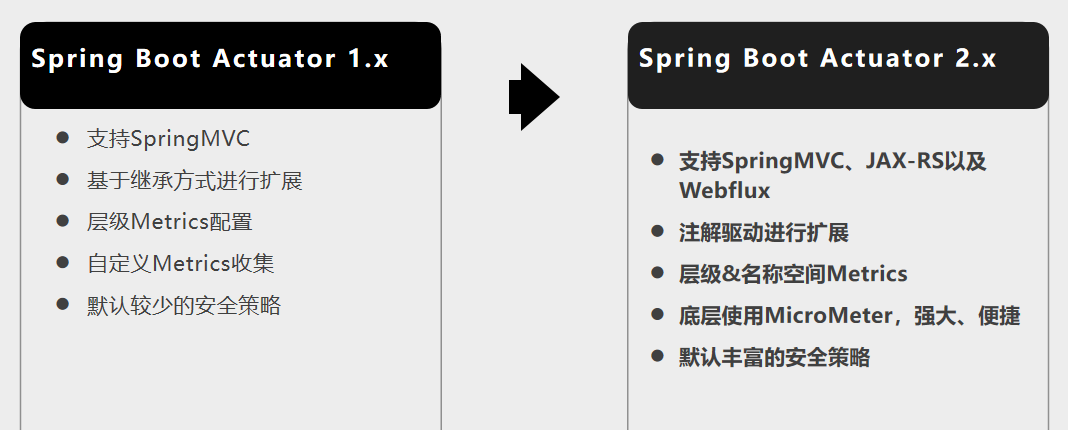
3、如何使用
- 引入场景
- 访问 http://localhost:8080/actuator/**
- 暴露所有监控信息为HTTP
management:endpoints:enabled-by-default: true #暴露所有端点信息web:exposure:include: '*' #以web方式暴露
- 测试
http://localhost:8080/actuator/beans
http://localhost:8080/actuator/configprops
http://localhost:8080/actuator/metrics
http://localhost:8080/actuator/metrics/jvm.gc.pause
http://localhost:8080/actuator/endpointName/detailPath
4、可视化
https://github.com/codecentric/spring-boot-admin
2、Actuator
1、最长使用的端点
| ID | 描述 |
|---|---|
auditevents | 暴露当前应用程序的审核事件信息。需要一个AuditEventRepository组件。 |
beans | 显示应用程序中所有Spring Bean的完整列表。 |
caches | 暴露可用的缓存。 |
conditions | 显示自动配置的所有条件信息,包括匹配或不匹配的原因。 |
configprops | 显示所有@ConfigurationProperties。 |
env | 暴露Spring的属性ConfigurableEnvironment |
flyway | 显示已应用的所有Flyway数据库迁移。 需要一个或多个Flyway组件。 |
health | 显示应用程序运行状况信息。 |
httptrace | 显示HTTP跟踪信息(默认情况下,最近100个HTTP请求-响应)。需要一个HttpTraceRepository组件。 |
info | 显示应用程序信息。 |
integrationgraph | 显示Spring integrationgraph 。需要依赖spring-integration-core。 |
loggers | 显示和修改应用程序中日志的配置。 |
liquibase | 显示已应用的所有Liquibase数据库迁移。需要一个或多个Liquibase组件。 |
metrics | 显示当前应用程序的“指标”信息。 |
mappings | 显示所有@RequestMapping路径列表。 |
scheduledtasks | 显示应用程序中的计划任务。 |
sessions | 允许从Spring Session支持的会话存储中检索和删除用户会话。需要使用Spring Session的基于Servlet的Web应用程序。 |
shutdown | 使应用程序正常关闭。默认禁用。 |
startup | 显示由ApplicationStartup收集的启动步骤数据。需要使用SpringApplication进行配置BufferingApplicationStartup。 |
threaddump | 执行线程转储。 |
如果您的应用程序是Web应用程序(Spring MVC,Spring WebFlux或Jersey),则可以使用以下附加端点:
| ID | 描述 |
|---|---|
heapdump | 返回hprof堆转储文件。 |
jolokia | 通过HTTP暴露JMX bean(需要引入Jolokia,不适用于WebFlux)。需要引入依赖jolokia-core。 |
logfile | 返回日志文件的内容(如果已设置logging.file.name或logging.file.path属性)。支持使用HTTPRange标头来检索部分日志文件的内容。 |
prometheus | 以Prometheus服务器可以抓取的格式公开指标。需要依赖micrometer-registry-prometheus。 |
最常用的Endpoint
- Health:监控状况
- Metrics:运行时指标
- Loggers:日志记录
2、Health Enndpoint
健康检查端点,我们一般用于在云平台,平台会定时的检查应用的健康状况,我们就需要Health Endpoint可以为平台返回当前应用的一系列组件健康状况的集合。
重要的几点:
- health endpoint返回的结果,应该是一系列健康检查后的一个汇总报告
- 很多的健康检查默认已经自动配置好了,比如:数据库、redis等
- 可以很容易的添加自定义的健康检查机制
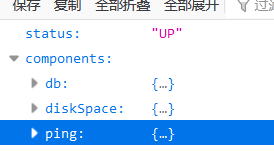
3、Metrics Enndpoint
提供详细的、层级的、空间指标信息,这些信息可以被pull(主动推送)或者push(被动获取)方式得到;
- 通过Metrics对接多种监控系统
- 简化核心Metrics开发
- 添加自定义Metrics或者扩展已有Metrics
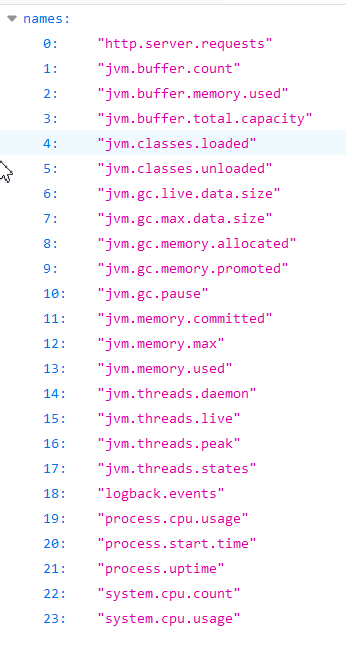
4、管理Endpoints
1、开启与禁用Endpoints
- 默认所有的Endpoint除过shutdown都是开启的。
- 需要开启或者禁用某个Endpoint。配置模式为 management.endpoint.****.enabled = true
management:endpoint:beans:enabled: true
- 或者禁用所有的Endpoint然后手动开启指定的Endpoint
management:endpoints:enabled-by-default: falseendpoint:beans:enabled: truehealth:enabled: true
2、暴露Endpoints
支持的暴露方式
- HTTP:默认只暴露health和info Endpoint
- JMX:默认暴露所有Endpoint
- 除过health和info,剩下的Endpoint都应该进行保护访问。如果引入SpringSecurity,则会默认配置安全访问规则
| ID | JMX | Web |
|---|---|---|
auditevents | Yes | No |
beans | Yes | No |
caches | Yes | No |
conditions | Yes | No |
configprops | Yes | No |
env | Yes | No |
flyway | Yes | No |
health | Yes | Yes |
heapdump | N/A | No |
httptrace | Yes | No |
info | Yes | Yes |
integrationgraph | Yes | No |
jolokia | N/A | No |
logfile | N/A | No |
loggers | Yes | No |
liquibase | Yes | No |
metrics | Yes | No |
mappings | Yes | No |
prometheus | N/A | No |
scheduledtasks | Yes | No |
sessions | Yes | No |
shutdown | Yes | No |
startup | Yes | No |
threaddump | Yes | No |
3、定制Endpoint
1、定制health信息
import org.springframework.boot.actuate.health.Health;
import org.springframework.boot.actuate.health.HealthIndicator;
import org.springframework.stereotype.Component;@Component
public class MyHealthIndicator implements HealthIndicator {@Overridepublic Health health() {int errorCode = check(); // perform some specific health checkif (errorCode != 0) {return Health.down().withDetail("Error Code", errorCode).build();}return Health.up().build();}}构建Health
Health build = Health.down().withDetail("msg", "error service").withDetail("code", "500").withException(new RuntimeException()).build();
management:health:enabled: trueshow-details: always #总是显示详细信息。可显示每个模块的状态信息
@Component
public class MyComHealthIndicator extends AbstractHealthIndicator {/*** 真实的检查方法* @param builder* @throws Exception*/@Overrideprotected void doHealthCheck(Health.Builder builder) throws Exception {//mongodb。 获取连接进行测试Map<String,Object> map = new HashMap<>();// 检查完成if(1 == 2){
// builder.up(); //健康builder.status(Status.UP);map.put("count",1);map.put("ms",100);}else {
// builder.down();builder.status(Status.OUT_OF_SERVICE);map.put("err","连接超时");map.put("ms",3000);}builder.withDetail("code",100).withDetails(map);}
}
2、定制info信息
info:appName: boot-adminversion: 2.0.1mavenProjectName: @project.artifactId@ #使用@@可以获取maven的pom文件值mavenProjectVersion: @project.version@
import java.util.Collections;import org.springframework.boot.actuate.info.Info;
import org.springframework.boot.actuate.info.InfoContributor;
import org.springframework.stereotype.Component;@Component
public class ExampleInfoContributor implements InfoContributor {@Overridepublic void contribute(Info.Builder builder) {builder.withDetail("example",Collections.singletonMap("key", "value"));}}
http://localhost:8080/actuator/info 会输出以上方式返回的所有info信息
3、定制Metrics信息
1、springboot支持自动适配的Metrics
-
JVM metrics, report utilization of:
-
- Various memory and buffer pools
- Statistics related to garbage collection
- Threads utilization
- Number of classes loaded/unloaded
-
CPU metrics
-
File descriptor metrics
-
Kafka consumer and producer metrics
-
Log4j2 metrics: record the number of events logged to Log4j2 at each level
-
Logback metrics: record the number of events logged to Logback at each level
-
Uptime metrics: report a gauge for uptime and a fixed gauge representing the application’s absolute start time
-
Tomcat metrics (
server.tomcat.mbeanregistry.enabledmust be set totruefor all Tomcat metrics to be registered) -
Spring Integration metrics
2、增加定制Metrics
class MyService{Counter counter;public MyService(MeterRegistry meterRegistry){counter = meterRegistry.counter("myservice.method.running.counter");}public void hello() {counter.increment();}
}//也可以使用下面的方式
@Bean
MeterBinder queueSize(Queue queue) {return (registry) -> Gauge.builder("queueSize", queue::size).register(registry);
}
4、定制Endpoint
@Component
@Endpoint(id = "container")
public class DockerEndpoint {@ReadOperationpublic Map getDockerInfo(){return Collections.singletonMap("info","docker started...");}@WriteOperationprivate void restartDocker(){System.out.println("docker restarted....");}}
场景:开发ReadinessEndpoint来管理程序是否就绪,或者Liveness****Endpoint来管理程序是否存活;
当然,这个也可以直接使用 https://docs.spring.io/spring-boot/docs/current/reference/html/production-ready-features.html#production-ready-kubernetes-probes
更多参考内容大厂学院
6、原理解析
1、Profile功能
为了方便多环境适配,springboot简化了profile功能。
1、application-profile功能
-
默认配置文件 application.yaml;任何时候都会加载
-
指定环境配置文件 application-{env}.yaml
-
激活指定环境
-
- 配置文件激活
- 命令行激活:java -jar xxx.jar –spring.profiles.active=prod --person.name=haha
-
-
- 修改配置文件的任意值,命令行优先
-
-
默认配置与环境配置同时生效
-
同名配置项,profile配置优先
2、@Profile条件装配功能
@Configuration(proxyBeanMethods = false)
@Profile("production")
public class ProductionConfiguration {// ...}
3、profile分组
spring.profiles.group.production[0]=proddb
spring.profiles.group.production[1]=prodmq使用:--spring.profiles.active=production 激活
2、外部化配置
https://docs.spring.io/spring-boot/docs/current/reference/html/spring-boot-features.html#boot-features-external-config
- Default properties (specified by setting
SpringApplication.setDefaultProperties). @PropertySourceannotations on your@Configurationclasses. Please note that such property sources are not added to theEnvironmentuntil the application context is being refreshed. This is too late to configure certain properties such aslogging.*andspring.main.*which are read before refresh begins.- Config data (such as
**application.properties**files) - A
RandomValuePropertySourcethat has properties only inrandom.*. - OS environment variables.
- Java System properties (
System.getProperties()). - JNDI attributes from
java:comp/env. ServletContextinit parameters.ServletConfiginit parameters.- Properties from
SPRING_APPLICATION_JSON(inline JSON embedded in an environment variable or system property). - Command line arguments.
propertiesattribute on your tests. Available on@SpringBootTestand the test annotations for testing a particular slice of your application.@TestPropertySourceannotations on your tests.- Devtools global settings properties in the
$HOME/.config/spring-bootdirectory when devtools is active.
1、外部配置源
常用:Java属性文件、YAML文件、环境变量、命令行参数;
2、配置文件查找位置
(1) classpath 根路径
(2) classpath 根路径下config目录
(3) jar包当前目录
(4) jar包当前目录的config目录
(5) /config子目录的直接子目录
3、配置文件加载顺序:
- 当前jar包内部的application.properties和application.yml
- 当前jar包内部的application-{profile}.properties 和 application-{profile}.yml
- 引用的外部jar包的application.properties和application.yml
- 引用的外部jar包的application-{profile}.properties 和 application-{profile}.yml
4、指定环境优先,外部优先,后面的可以覆盖前面的同名配置项
3、自定义starter
1、starter启动原理
- starter-pom引入 autoconfigurer 包
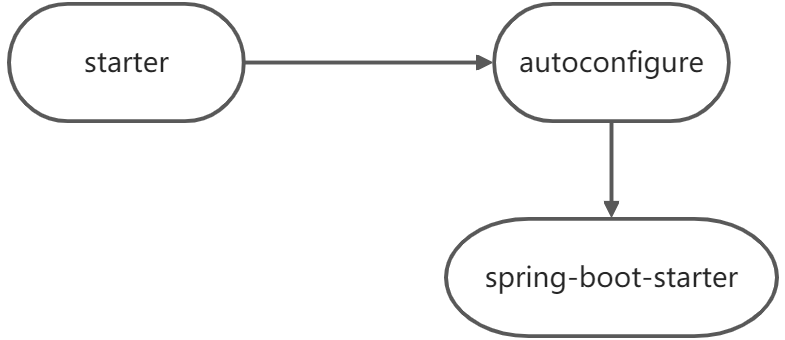
-
autoconfigure包中配置使用 META-INF/spring.factories 中 EnableAutoConfiguration 的值,使得项目启动加载指定的自动配置类
-
编写自动配置类 xxxAutoConfiguration -> xxxxProperties
-
- @Configuration
- @Conditional
- @EnableConfigurationProperties
- @Bean
- …
引入starter — xxxAutoConfiguration — 容器中放入组件 ---- 绑定xxxProperties ---- 配置项
2、自定义starter
atguigu-hello-spring-boot-starter(启动器)
atguigu-hello-spring-boot-starter-autoconfigure(自动配置包)
4、SpringBoot原理
Spring原理【Spring注解】、SpringMVC原理、自动配置原理、SpringBoot原理
1、SpringBoot启动过程
-
创建 SpringApplication
-
- 保存一些信息。
- 判定当前应用的类型。ClassUtils。Servlet
- bootstrappers**:初始启动引导器(List):去spring.factories文件中找** org.springframework.boot.Bootstrapper
- 找 ApplicationContextInitializer;去spring.factories****找 ApplicationContextInitializer
-
-
- List<ApplicationContextInitializer<?>> initializers
-
-
- 找 ApplicationListener ;应用监听器。去spring.factories****找 ApplicationListener
-
-
- List<ApplicationListener<?>> listeners
-
-
运行 SpringApplication
-
- StopWatch
- 记录应用的启动时间
- **创建引导上下文(Context环境)**createBootstrapContext()
-
-
- 获取到所有之前的 bootstrappers 挨个执行 intitialize() 来完成对引导启动器上下文环境设置
-
-
- 让当前应用进入headless模式。java.awt.headless
- 获取所有 RunListener**(运行监听器)【为了方便所有Listener进行事件感知】**
-
-
- getSpringFactoriesInstances 去spring.factories****找 SpringApplicationRunListener.
-
-
- 遍历 SpringApplicationRunListener 调用 starting 方法;
-
-
- 相当于通知所有感兴趣系统正在启动过程的人,项目正在 starting。
-
-
- 保存命令行参数;ApplicationArguments
- 准备环境 prepareEnvironment();
-
-
- 返回或者创建基础环境信息对象。StandardServletEnvironment
- 配置环境信息对象。
-
-
-
-
- 读取所有的配置源的配置属性值。
-
-
-
-
- 绑定环境信息
- 监听器调用 listener.environmentPrepared();通知所有的监听器当前环境准备完成
-
-
- 创建IOC容器(createApplicationContext())
-
-
- 根据项目类型(Servlet)创建容器,
- 当前会创建 AnnotationConfigServletWebServerApplicationContext
-
-
- 准备ApplicationContext IOC容器的基本信息 prepareContext()
-
-
- 保存环境信息
- IOC容器的后置处理流程。
- 应用初始化器;applyInitializers;
-
-
-
-
- 遍历所有的 ApplicationContextInitializer 。调用 initialize.。来对ioc容器进行初始化扩展功能
- 遍历所有的 listener 调用 contextPrepared。EventPublishRunListenr;通知所有的监听器****contextPrepared
-
-
-
-
- 所有的监听器 调用 contextLoaded。通知所有的监听器 contextLoaded;
-
-
- **刷新IOC容器。**refreshContext
-
-
- 创建容器中的所有组件(Spring注解)
-
-
- 容器刷新完成后工作?afterRefresh
- 所有监听 器 调用 listeners.started(context); 通知所有的监听器 started
- **调用所有runners;**callRunners()
-
-
- 获取容器中的 ApplicationRunner
- 获取容器中的 CommandLineRunner
- 合并所有runner并且按照@Order进行排序
- 遍历所有的runner。调用 run 方法
-
-
- 如果以上有异常,
-
-
- 调用Listener 的 failed
-
-
- 调用所有监听器的 running 方法 listeners.running(context); 通知所有的监听器 running
- **running如果有问题。继续通知 failed 。**调用所有 Listener 的 **failed;**通知所有的监听器 failed
public interface Bootstrapper {/*** Initialize the given {@link BootstrapRegistry} with any required registrations.* @param registry the registry to initialize*/void intitialize(BootstrapRegistry registry);}
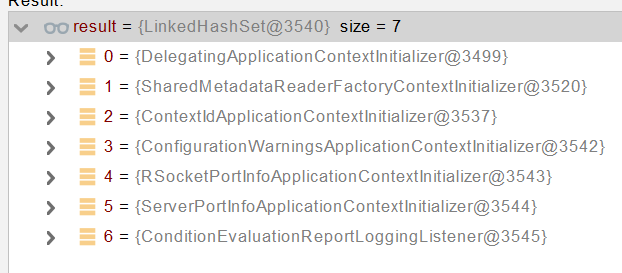
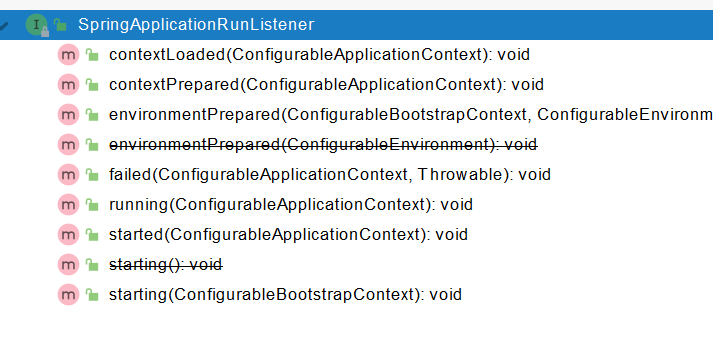

@FunctionalInterface
public interface ApplicationRunner {/*** Callback used to run the bean.* @param args incoming application arguments* @throws Exception on error*/void run(ApplicationArguments args) throws Exception;}
@FunctionalInterface
public interface CommandLineRunner {/*** Callback used to run the bean.* @param args incoming main method arguments* @throws Exception on error*/void run(String... args) throws Exception;}
2、Application Events and Listeners
https://docs.spring.io/spring-boot/docs/current/reference/html/spring-boot-features.html#boot-features-application-events-and-listeners
ApplicationContextInitializer
ApplicationListener
SpringApplicationRunListener
3、ApplicationRunner 与 CommandLineRunne
参考资源
语雀笔记:https://www.yuque.com/atguigu/springboot/
参考视频:尚硅谷雷神SpringBoot2零基础入门springboot全套完整版(spring boot2)https://www.bilibili.com/video/BV19K4y1L7MT?p=87&spm_id_from=333.880.my_history.page.click
springboot注解
@configurationProperties(“spring.datasource”)
自定义组件,绑定配置信息,从“spring.datasource”中
@Deprecated(不推荐使用,弃用)
废弃视使用的配置方式,配置组件,不再使用该组件。
@TableFiled(exist=false)
该注解下的参数在数据库中没有设置
@PathVariable
@PathVariable:这个参数相当于在@GetMapping(“/car/{id}/owner/{username}”)中去获取参数直接到方法中。
@RequestHeader:
这个是获取请求头的信息。可以携带参数,也可以获取全部的请求参数。
@ModelAttribute:
@RequestParam:获取请求参数
@MatrixVariable:矩阵变量
@CookieValue:获取cookie的值
@RequestBody:获取请求体的参数
;ApplicationArguments
- 准备环境 prepareEnvironment();
-
-
- 返回或者创建基础环境信息对象。StandardServletEnvironment
- 配置环境信息对象。
-
-
-
-
- 读取所有的配置源的配置属性值。
-
-
-
-
- 绑定环境信息
- 监听器调用 listener.environmentPrepared();通知所有的监听器当前环境准备完成
-
-
- 创建IOC容器(createApplicationContext())
-
-
- 根据项目类型(Servlet)创建容器,
- 当前会创建 AnnotationConfigServletWebServerApplicationContext
-
-
- 准备ApplicationContext IOC容器的基本信息 prepareContext()
-
-
- 保存环境信息
- IOC容器的后置处理流程。
- 应用初始化器;applyInitializers;
-
-
-
-
- 遍历所有的 ApplicationContextInitializer 。调用 initialize.。来对ioc容器进行初始化扩展功能
- 遍历所有的 listener 调用 contextPrepared。EventPublishRunListenr;通知所有的监听器****contextPrepared
-
-
-
-
- 所有的监听器 调用 contextLoaded。通知所有的监听器 contextLoaded;
-
-
- **刷新IOC容器。**refreshContext
-
-
- 创建容器中的所有组件(Spring注解)
-
-
- 容器刷新完成后工作?afterRefresh
- 所有监听 器 调用 listeners.started(context); 通知所有的监听器 started
- **调用所有runners;**callRunners()
-
-
- 获取容器中的 ApplicationRunner
- 获取容器中的 CommandLineRunner
- 合并所有runner并且按照@Order进行排序
- 遍历所有的runner。调用 run 方法
-
-
- 如果以上有异常,
-
-
- 调用Listener 的 failed
-
-
- 调用所有监听器的 running 方法 listeners.running(context); 通知所有的监听器 running
- **running如果有问题。继续通知 failed 。**调用所有 Listener 的 **failed;**通知所有的监听器 failed
public interface Bootstrapper {/*** Initialize the given {@link BootstrapRegistry} with any required registrations.* @param registry the registry to initialize*/void intitialize(BootstrapRegistry registry);}
[外链图片转存中…(img-8D0dlES9-1650439603430)]
[外链图片转存中…(img-ez6Uk17m-1650439603431)]
[外链图片转存中…(img-1DullcXL-1650439603431)]
@FunctionalInterface
public interface ApplicationRunner {/*** Callback used to run the bean.* @param args incoming application arguments* @throws Exception on error*/void run(ApplicationArguments args) throws Exception;}
@FunctionalInterface
public interface CommandLineRunner {/*** Callback used to run the bean.* @param args incoming main method arguments* @throws Exception on error*/void run(String... args) throws Exception;}
2、Application Events and Listeners
https://docs.spring.io/spring-boot/docs/current/reference/html/spring-boot-features.html#boot-features-application-events-and-listeners
ApplicationContextInitializer
ApplicationListener
SpringApplicationRunListener
3、ApplicationRunner 与 CommandLineRunne
参考资源
语雀笔记:https://www.yuque.com/atguigu/springboot/
参考视频:尚硅谷雷神SpringBoot2零基础入门springboot全套完整版(spring boot2)https://www.bilibili.com/video/BV19K4y1L7MT?p=87&spm_id_from=333.880.my_history.page.click
